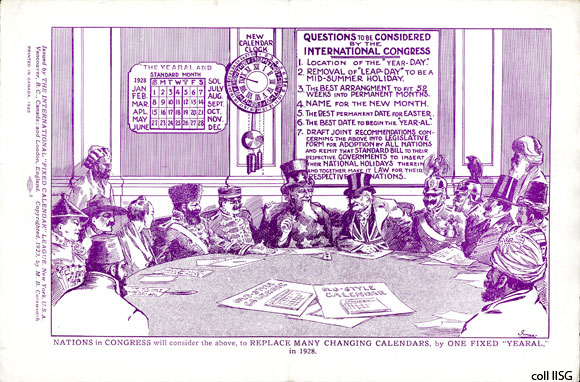A collection of essays, modules, random lists of links, etc. (in various degrees of polish) supporting the Time class. As time touches every aspect of everything, this page will be, necessarily, incomplete.
[Home | 02024 Syllabus | Ideas | Resources | Gallery]
- Categories
- An Ancient Calculator
- Ratios, Rates, and Resonance
- Time’s Arrow & Time’s End
- Relativity and the Speed of Light
- Sundials
- Timekeeping Devices
- Watch Face Design
- Watch Movements
- Complications
- Bad Clocks
- Calendars
- Seeing Time
- From Data To Meaning
- Existing in Time
- Technical Topics – Notes
- Jay Griffiths on Time
- Time in Fiction
Categories
My thinking about time falls into several categories. There are maybe more interconnections between categories than boundaries, but I still find it useful to delineate the general map.
- Scale: How can you feel the vastness of time?
- The Past: The history of humanity, life on earth, the earth itself, the universe.
- The Future: The immensity of the future, longtermism, the Doomsday Equation.
- Science: What does science say about time?
- Astronomy: The changing sky is the foundation for our conception of time. Days, months, seasons, years. Looking at stars is looking into the past.
- Physics: The arrow of time. Entropy. The past hypothesis. The temporally vast multiverse. Does time exist (at what level of reality)? Does that matter?
- Neuroscience: How to our minds encode time?
- Culture: How do people around the world and throughout history conceive of, relate to, and represent time?
- Language, Religion, Holidays, Artifacts, Practices, Calendars, Counting age, Elders
- Politics: How is time a venue for power?
- Time zones, Zero Years, DST, month and day names, work and leisure
- Craft: The things humans have invented for tracking time.
- Sundials, clepsydras, observatories, the Antikythera Mechanism, astrolabes, armillary spheres, orreries, clocks, watches, computers.
An Ancient Calculator
In 1901 an unremarkable hunk of corroded metal and rotted wood was recovered from a sunken shipwreck off the island of Antikythera, Greece. It had been on the ocean floor for nearly two thousand years, and it would remain largely unexamined until 70 years later, when advances in X-ray and gamma imaging would expose previously unimagined internal detail to the device now known as the Antikythera Mechanism. The images revealed complex clockwork (with comments in the code!), eventually understood, after much deduction, to be a kind of mechanical analog computer for tracking the passage of time. Hands indicated the position of the sun, moon and planets, as well as the moon’s phase, and a special section was dedicated to the schedule of the Olympic Games. Whatever fabrication techniques and mathematics the device embodied were lost to the ages – no known object approaching its intricacy would appear in the world for another 1000 years.

The Antikythera Mechanism is an almost unbelievable anachronism, like finding an airplane in an ancient tomb. Yet at the time it was made, it already represented the heritage of thousands of years of human curiosity about the passage of time. This curiosity spans cultures, and was present when our earliest ancestors learned to find patterns in the seasons, the migrations of animals, the tides, the apparent motions of stars and planets and the moon across the sky. Mathematics developed to describe and generalize these patterns, allowing early humans to make vital predictions; tools were invented that reflected the mathematics in mechanisms to assist those prehistoric scientists; skills to make and use those tools were passed from generation to generation. How many other mechanisms like the Antikythera were invented and lost and invented again? Reflecting on the nature of time connects us to a vast human enterprise that stretches from the first glimmers of reason to our highest achievements.
Further reading: The Smithsonian, Nature, University College London video
Ratios, Rates, and Resonance
The Antikythera Mechanism is not a timekeeper per se. It has no automatic drive moving it forward at a set rate, but rather, an operator provides an input through a crank. It doesn’t matter if the crank is turned fast or slow, the purpose of the machine is to maintain a precise set of ratios between the motion of the crank and changes in position of various indicators on the front and back of the device. The Antikythera mechanism encodes a program mapping an input to an output, and this program can run at any speed. Time keepers have to run at the speed of the universe (1 second per second as per Carroll).
Early timekeepers relied on naturally occurring oscillations such as the daily motion of the sun across the sky to track time. A simple stick set in the ground becomes a ‘gnomon’, the shadow casting element of a sundial, from which much about the daily and yearly motion of the sun can be learned (‘gnosi’ is the Proto-Indo-European root for ‘knowledge’). The west-to-east motion of the shadow from dawn to dusk marks the temporal, variable hours of the day. Each day the shortest shadow occurs at local apparent noon, midway from sunrise to sunset, when the sun is highest above the horizon; but this shortest noon shadow also changes through the seasons, lengthening (in the Northern hemisphere) from the base of the gnomon in the winter when the sun is low, and contracting as the sun peaks higher in the summer sky.
The first artificial timekeepers relied on the steady flow of a process to mark time. A ‘clepsydra’ or ‘water thief’ is simply a container of water that leaks at a predictable rate; markings can show the passage of time by how much water has been lost. Similarly candles or incense sticks that burn at a predictable rate (determined perhaps by comparison to a sundial) can be used to mark time.
An important advance was made around 725AD by the Tang dynasty astronomer Yi Xing (行) (683–727AD). He is credited with developing the first escapement, where the continuous flow of water in a water-wheel clock was checked and quantized into discreet steps. This concept was also used in the famous astronomical clock tower of Su Song (苏颂) (1020-1101AD), which turned a model of the heavens in real time. In each mechanism, the drive wheel was designed such that it was locked in place until enough water filled a vessel and unlocked the wheel for a single step. This transformed the continuous variable of the rate of flow of water over a wheel into discreet, countable steps.
The modern timekeeper architecture would be complete once an energy source and an escapement was combined with an oscillator. Pendulums, sprung masses, crystal vibrations, and the movement of atoms themselves have all been harnessed to track time.
Large phenomena, like the revolutions of a planet about its star, are usually also slow. Nature’s most ephemeral, fastest oscillations make the most precise, and potentially universal, references for clocks. The four Pioneer and Voyager space probes, launched by NASA in the 1970s, contain a depiction of time intended to be understood by any intelligence the probes might, however unlikely, encounter. They depict an atom of hydrogen, the most abundant element in the universe, undergoing a spin-flip transition of its electron:
“The spin-flip transition of a hydrogen atom’s electron has a frequency of about 1420.405 MHz, which corresponds to a period of 0.704 ns. Light at this frequency has a vacuum wavelength of 21.106 cm (which is also the distance the light travels in that time period). Below the symbol, the small vertical line—representing the binary digit 1—specifies a unit of length (21 cm) as well as a unit of time (0.7 ns). Both units are used as measurements in the other symbols.[4]” Wikipedia
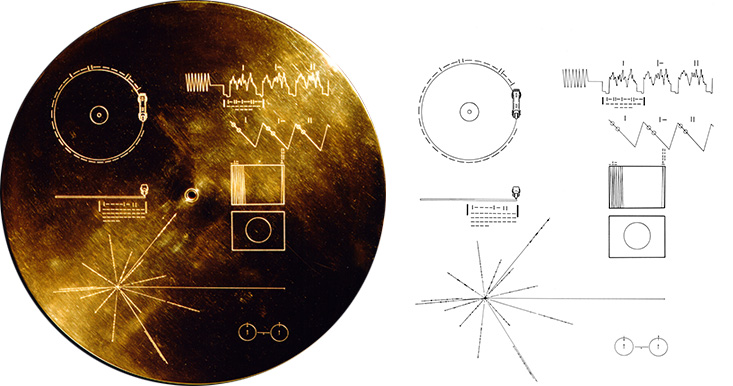
This unit of time, 0.704 ns, is used as the basis of a binary representation of time elsewhere in the symbols engraved on the probes. The solar system’s location in the galaxy is given by its relationship to 14 pulsars, identified by their precise periods using this binary notation, and on the Voyager records, the method for decoding their time-based signals also uses this notation. These probes are the first human-made objects to leave the solar system, and will continue until the end of time (if undisturbed) traveling across a universe defined in light-years, or the length light can travel in the time the Earth completes one revolution around its star.
Time’s Arrow & Time’s End
How could time end? Although a fundamental aspect of existence, time is impossible to isolate from the changing phenomena that mark its apparent passage. Of time, Einstein stated that “time is that which clocks measure”, and measurement requires an observable change. In one possible far future of the universe, maximum entropy is achieved and heat-death renders all differences between regions of space null. Particles themselves decay, and no pocket of order remains in a sea of cold disorder. Change is no longer possible. When clocks cannot operate, time ends.
This progression from low-entropy order to high-entropy disorder, referred to as the “arrow of time”, has been proposed as the reason time seems to us to flow forward from past to future even while the underlying physics, when considered at a small enough scale, seem indifferent to which direction time goes.
Relativity and the Speed of Light
Do time and space exist independently of events and objects? Before Newton, various schools of thought went back and forth on this issue. However, Newton seemed to put the issue to rest. In his Principia, he declared “absolute, true, and mathematical” time and space exist separate from our relative, common understanding of them, which can only arise from perceptions of phenomena. Absolute space is the arena in which all things are placed, and absolute time is the true sequence and duration of events, regardless of how or if they are manifest as phenomena. Since Newton produced powerful results using these assumptions – the laws of motion that accurately describe the orbits of the planets (except Mercury, sort of… more on that later) – that seemed to settle the issue: Absolute time (and space) exists.
Two puzzles were bothersome, but no where near enough to throw out the result. Mercury’s motion seemed a bit weird – close to what Newton predicted but off just enough that it probably wasn’t a measurement error. All other planets seemed predicted perfectly. Second puzzle: mass seems to manifest itself in two separate ways that just so happen to balance each other out. When gravity acts on a body, it does so in proportion to its gravitational mass and imparts a force on it resulting in an acceleration. Any acceleration, including gravity, is proportional to the force applied to a body and inversely proportional to its inertial mass. Thus, lead and wood fall at the same velocity – the attraction is greater for lead, but so is the inertia, so the resulting motion is the same. The coincidental equivalence of gravitational and inertial mass was troublesome.
Although Newton used his calculus to work out his theories, he presented the arguments in Principia geometrically (so as to be understandable to his contemporaries). The idea of pure, absolute time and space share an underlying similarity to Euclid’s conceptions of perfect idealized geometric concepts like a zero-dimensional point or a line with infinite length but no width – ideas that we could conceive of and reason with even though we never directly encounter them in reality.
Keep in mind that the term relativity already existed for Newton, from Galileo’s concept of the inertial invariance of laws of motion. It doesn’t matter if a ship is moving across the water relative to land, or a planet through space relative to the galaxy – a set of objects can share an inertial frame of reference, and laws relating to their motion apply. A ball dropped from a moving ship will appear to fall straight down from the reference point of the ship, as it would on land. The same ship-bound ball, when viewed from land however, will follow a curved path relative to a reference point of the shore because of the relative velocity between the frames. No problem.
Leading up to Einstein, we must note another development. The relationship between two seemingly separate forces was characterized by Faraday: Electricity and magnetism came to be seen as related aspects of the same fundamental force. This relationship was quantified by Maxwell’s equations governing electromagnetism.
However, there was a problem, which would become a defining problem in physics in the early 1900s: Maxwell’s equations (which, like Newton’s, have far-reaching explanatory power) insist that there is a fixed speed at which light propagates. Not in relationship to an observer, or an inertial frame of reference, but absolute. One interpretation was that this speed is relative, but to an as-yet-unknown medium, dubbed “ether”. Scientists began searching for evidence of the ether. (See the Michelson-Morley and Fizeau experiments.) No evidence of ether was found, yielding a null result that puzzled scientists at the time. Enter Einstein.
In 1905, railways were growing, and for the first time, people could move from point to point fast enough that the relative local times – based on solar noon at a precise location – become a problem. If a train is leaving village A at noon for town A, what time is it in town B, where it will arrive? Coordinating the movement of trains and clocks was a pertinent problem of the day. Einstein, working in a patent office, must have reviewed proposed solutions to coordinating time along railroad tracks. And he was puzzled by the null result for ether – why do all measurements of light seem to yield the same velocity, regardless of the motion of the observer?
in 1905, the so-called Annus Mirabilis, he published 4 papers, including on the Electrodynamics of Moving Objects. Using a geometrical argument, he took as granted that all observers will measure the same velocity for light regardless of their relative velocity, and rearranged space and time to account for different inertial frames, given the special case that those frames were moving relative to one another in a straight line at uniform velocity: Special Relativity. In short, as velocity increases, time slows down and space contracts in the direction of motion. Incorporating an idea from his teacher Minkowsky, Einstein simplified the geometrical equations with three spatial variables + time to a four-dimensional space where time has a imaginary component, known as the Lorentz transformation.
Another 10 years of thinking applied relativity to all forms of motion (accelerative/curved as well as uniform) and unified inertial and gravitational mass: General Relativity. This theory correctly predicted motion of Mercury, and that light would bend in a gravitational field. This leads to the notion of curved space time.
Sundials
The source of knowledge
A sundial casts a shadow that moves as the earth moves. The shadow casting “thing” (a stick in the ground, a triangular plate, etc) is called the “gnomon”, a word with origins in the Proto Indo-European language’s root “gno”, “to know”. To study the shadow is to study the world.
Sundials can be as simple as a stick in the ground, as with the oldest known, the Taosi Gnomon from Xiangfan, 1900BCE, or as elaborate as the monumental instruments at Uraniborg, Jantar Mantar, or Guguanxiangtai. There are many types, including horizontal, vertical (facing any direction, including north), equatorial, polar, and analemmatic sundials. They can tell “temporary” hours when every sunlight period is divided into the same number of parts (usually 6 before and 6 after the noon meridian), yielding long winter hours and short summer hours; or “vulgar” hours, as we generally do now, dividing each mean solar day into equal segments (24). They may or may not include adjustments for the Equation of Time (see also here). If your home has a window that receives direct sunlight, your home is a kind of sundial. If any star were bright enough to cast a shadow, there might be sidereal dials; the moon can, sometimes, and there are moondials.
You are a quick google search away from finding countless templates and sundial generators. To get you started, here is a traditional horizontal dial generator and one for vertical dials; several more are listed in the section on software tools on this site.

Astrolabes, armillary spheres, orreries, planetaria and astraria, volvelles, and heliostats are all related to sundials (isn’t this vocabulary great!!). Extending our metaphor, anything that changes in relation to another phenomenon, and calls attention to, magnifies, or delineates that change is a cousin to the sundial. The phenomena could be natural or synthetic, universal or personal.

Jattuporn’s Red Moon – a moondial? Source
Timekeeping Devices
All hail the escapement
The ingenuity of mechanical timekeepers lies in the interface between an oscillator (like a pendulum) and source of energy (like a falling weight). All mechanical clocks have something that can periodically halts and resume the flow of energy in a subtle way called the escapement, regulating and converting a flow into a count.
The escapement acts as a trigger mechanism that locks the gear train of the timekeeper until a small movement from the oscillator unlocks it momentarily. This allows the gear train to advance one step, whereupon it is immediately re-locked by the escapement. At this happens, a small amount of energy from the energy source is transferred to the oscillator, giving it a kick that keeps it running. Without the oscillating timer and escapement, the energy source would simply and rapidly unwind, driving the display forward at an unregulated maximum speed.
Before I proceed, I should direct you to some beautiful visual representations of how watches and clocks work. The best I’ve seen is Bartosz Ciechanowski’s in-depth interactive about watches (worth looking at for the virtuosic JS coding alone – check under the hood, it’s nuts!).
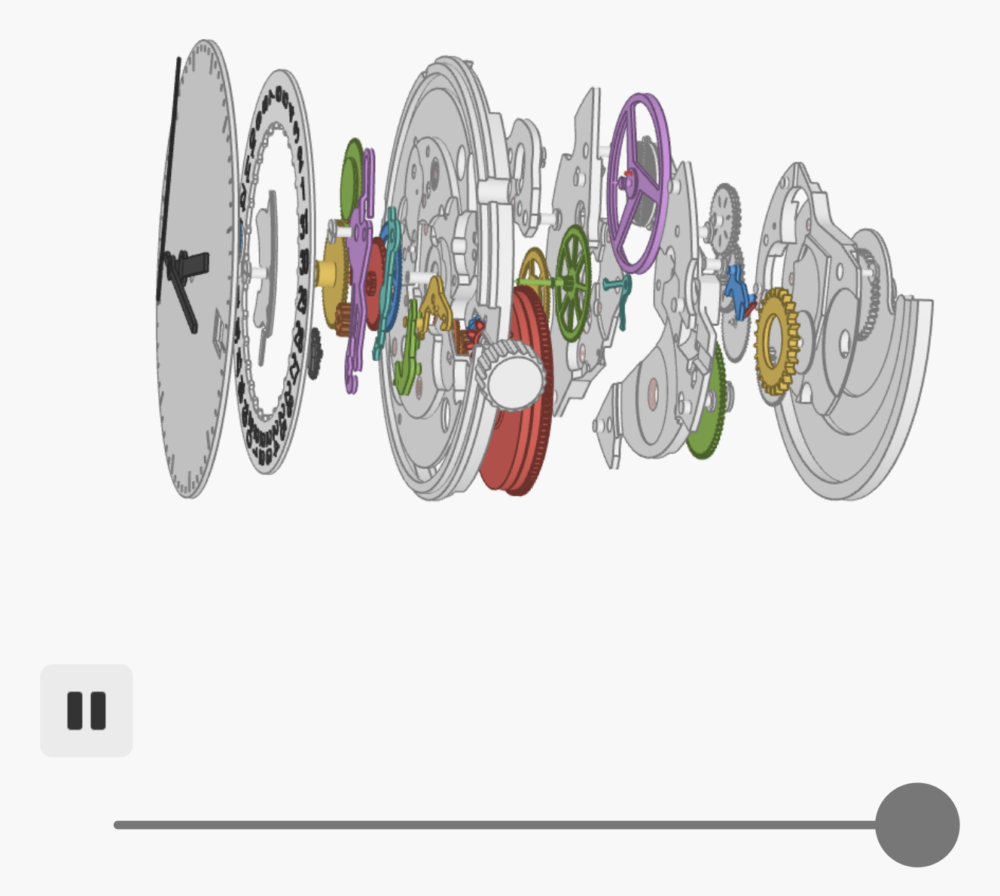
Hodinkee’s Watch 101 is also excellent. This 1949 video [https://www.youtube.com/watch?v=rL0_vOw6eCc] from the Hamilton Watch Company is both an interesting anachronism and a clear visual explanation using oversized mechanical models and stop motion; this more recent CG video [https://www.youtube.com/watch?v=9_QsCLYs2mY] is more concise.
The energy source is usually a descending weight or wound spring, although effects as subtle as barometric pressure changes have been harnessed.
The display is typically one or more hands indicating at least the hour, and maybe minutes and seconds too. The display is coupled to the energy source through gears (called wheels in horology). While these are ingenious and fabricated to amazing precision at a tiny scale, their function is relatively simple – to convert pulses from the escapement into the correct representation of the current time. Once you have a second hand revolving once per minute, it is a simple matter of gear 60:1 gear ratios to convert that to the minute hand movement, and again to the hour hand.
A huge variety of solutions to all aspects of timekeeping can be found in historical and current examples. While three hands (hours, minutes, seconds) is typical, other varieties abound: mecha-numerical displays, jumping indicators, retrograde indicators that reset after reaching an extreme, etc.
Watch Face Design
Repetition and variation
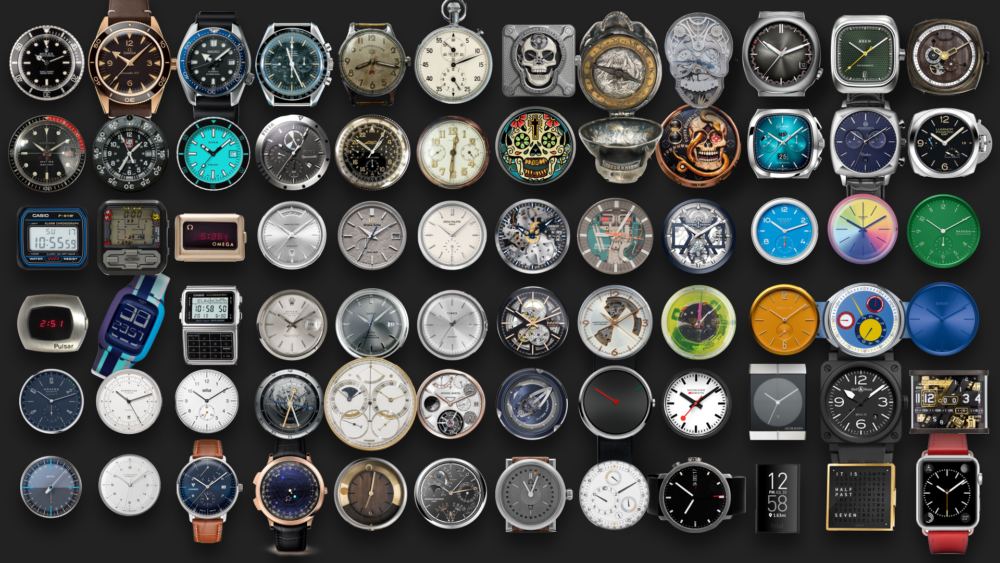
I don’t want the “Time” course to be just about cool consumer watches and clocks. But dammit, they are cool! And they have a place at ITP as excellent examples of information- and industrial-design. A watch* is a wearable machine (made to incredible precision) for displaying information. What info and how is worth studying, and if we look at the world of watches we have decades of fascinating examples of how this highly constrained problem is solved. The watch industry is also an example of slowly-evolving high/low technology. Traditional watch makers almost put themselves out of business by inventing quartz movements, but have remained viable through marketing/fetishizing less accurate but more romantic mechanical movements.
(*Clocks are also interesting for many of the same reasons, but since they don’t need to be wearable, they have fewer constraints and so wider design solutions at many different scales. Watches must be small enough to be worn and tough enough to keep accurate time while being banged around.)
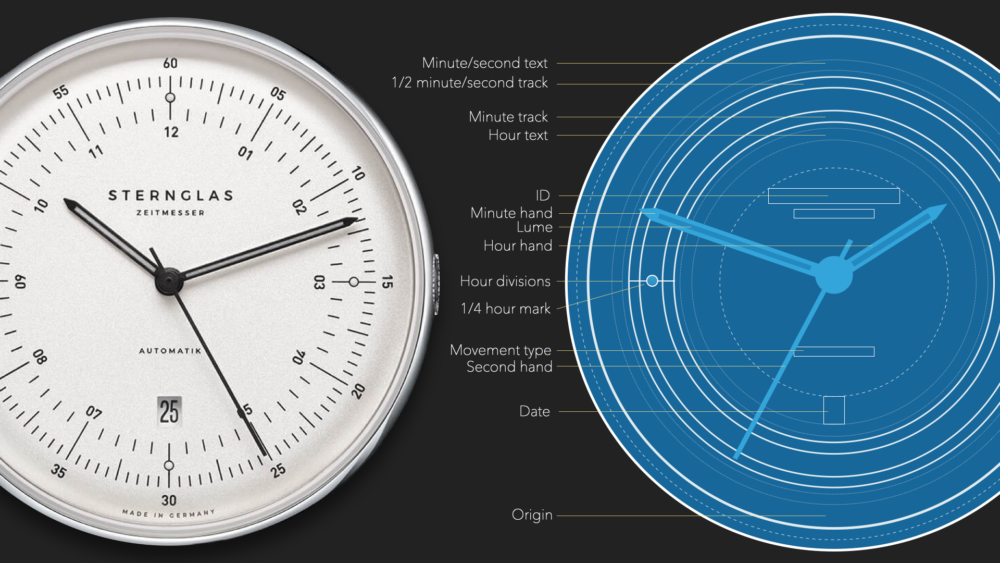
Edward R. Tufte, in his 1990 book Envisioning Information, introduces the concept of “small multiples.” In this data visualization technique, many variants of a dataset are arrayed together in a single image field, allowing easy comparison and contrast between sets. “Small multiples reveal, all at once, the scope of alternatives, a range of options.”
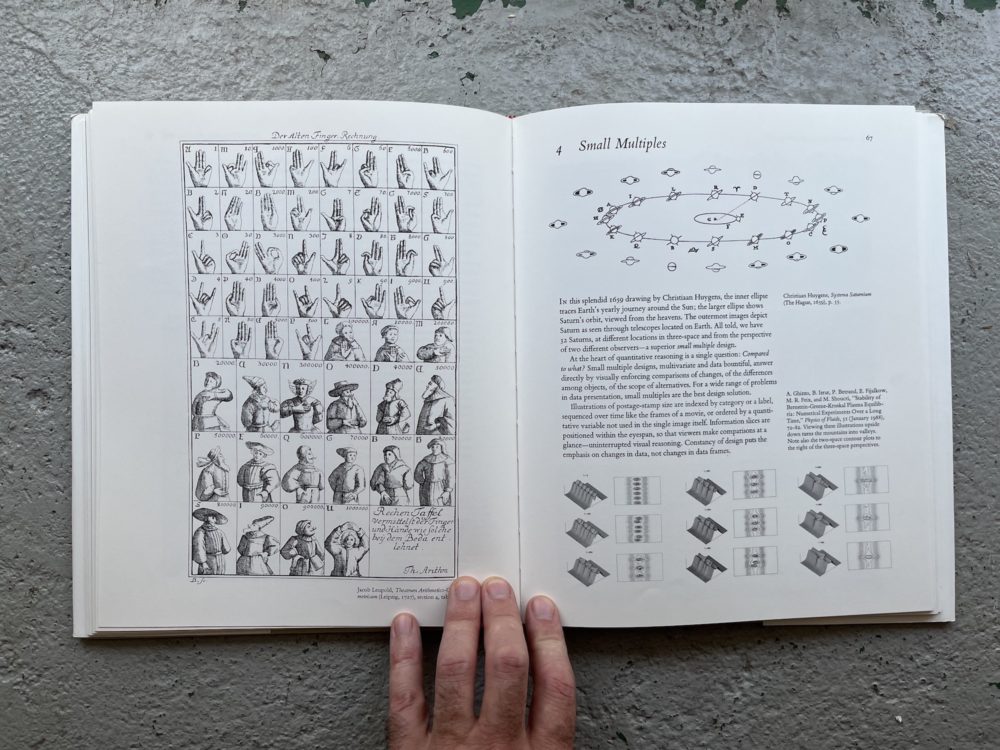
To me, small multiples are uniquely satisfying. It feels comforting survey an entire landscape at once, able to mentally zoom into neatly compartmentalized details. To the extent that I have a “collector impulse”, I suspect this has something to do with it: it is interesting to me to understand the total scope of something – say, electric guitars – and understand how each particular example fits into the whole (“Les Pauls are like this, while Fenders are like this”). Perhaps others feel the same.
Watch face design yields excellent small multiples. Each design attempts to solve the same problem: present the time legibly in a constrained space. Many (but not all!) arrive at a circular or near-circular design, a natural consequence of a rotation-based mechanism tracking daily cycles. Many (but not all!) use two or three hands around a central pivot, with typical (but not universal) features distinguishing the various hands (hour hand is shorter and wider than minute hand, for example). Dials and the markings on them exhibit a huge variety of color, texture, and proportion. Beyond the basic hours, minutes, and seconds, many watches include complications such as date, day of the week, month, lunar cycle, and more.
All of this assumes that the purpose of the watch is to tell the literal time – how many seconds have elapsed since midnight. Since the literal time is so abundant today as to be a cheap commodity (not always at all the case), artists working with clock-like objects often explore what I think of as “Bad Clocks” – clocks that attempt to speak to some aspect of time – psychological, cultural, personal – beyond the simply literal.
And further, this discussion so far ignores the internals of the watch (the “movements”, which themselves have a fascinating variety and history, more on that elsewhere). But confining ourselves to the external appearance of a watch, there is endless variety to explore.
Watch Movements
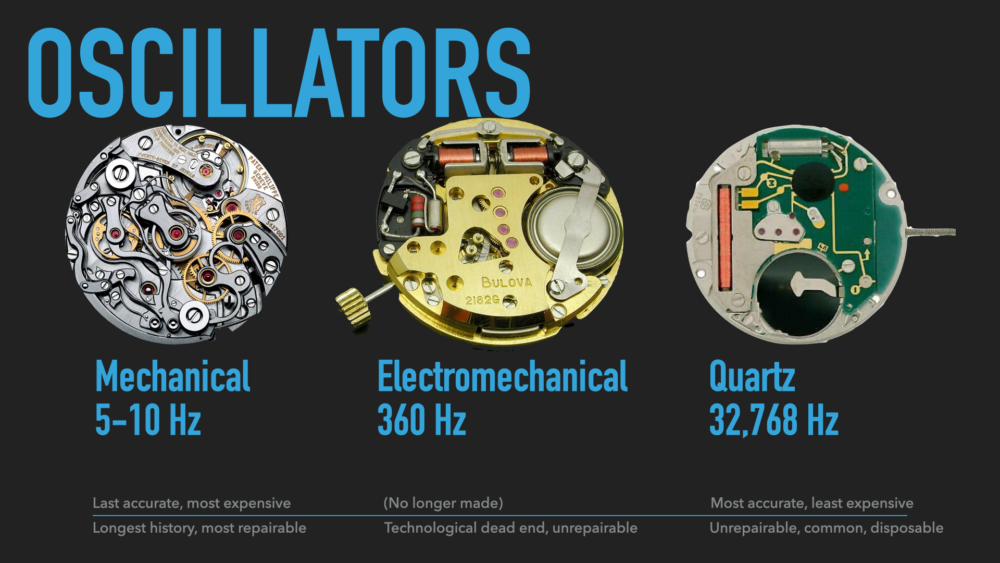
Two great animated/interactive
resources:
Complications
In horology, anything beyond the basic function of representing the hours, minutes, and seconds is given the wonderful name “complication.” The date? A complication. the month and day of the week? A complication. An hour hand that jumps in integers instead of moving gradually? A complication. The list is long and interesting.
Can we riff on idea of “complications” in new media projects? Can we identify a core idea (the “simple movement”) that can be elaborated upon and strengthened by the addition of complications? Can we demonstrate skill in implementation in a way that draws our participants further into the project? Can we delight people with surprise features that reveal themselves to the persistent? Or should we strive to remove complications, streamlining our work to its essential core?
Bad Clocks
Good clocks – that tell time with extreme accuracy – are a commodity now. The world is filled with hyper-accurate clocks. When inventing new clocks, artists tend to be interested in ‘bad’ ones: clocks that may be less accurate in terms of GMT, but get at some other aspect of time – a personal or psychological or cultural or linguistic aspect. A Griffiths Clock. Less accurate but more meaningful.
Calendars
I am a Tuesday.
The International Fixed Calendar was a proposal to “rationalize” the Gregorian calendar proposed by Moses B. Cotsworth in 1902. In Cotsworth’s calendar, every month would have 4 weeks (28 days); the year would have 13 months, adding a new month, Sol in the middle. A new holiday, “Year Day”, would be added after December 28th, with no day of the week (likewise, a Leap Year would include the 29th of Sol and have no associated day).
One consequence of such a calendar is that every date always falls on the same day of the week every year. My birthday, July 11, is Sol 24 in the IFC, and that date is, and always will be, a Tuesday. Riffing with LowRes Time student Anney Norton in 2023, we hit on the fun idea that having your birthday on the same day of the week every year would affect your personality. Imagine the difference between a Tuesday (such as myself) and a Friday or Saturday. Every year their birthday aligns with the weekend; while mine falls in the dreary weekday. How would that shape our lives? How outgoing and fun-loving they must become; and how dull for me.
(Also – as there are non-named holiday days, it’s possible that your birthday falls on one of those…)
With that in mind, I adapted some code I found to convert your birthday to it’s IFC equivalent. What day of the week are you?
(BTW – my two kids and spouse loved this, as they determined that they are Thursdays, Fridays, and Saturdays, and immediately began lording it over me.)
Seeing Time
Time-Based Media
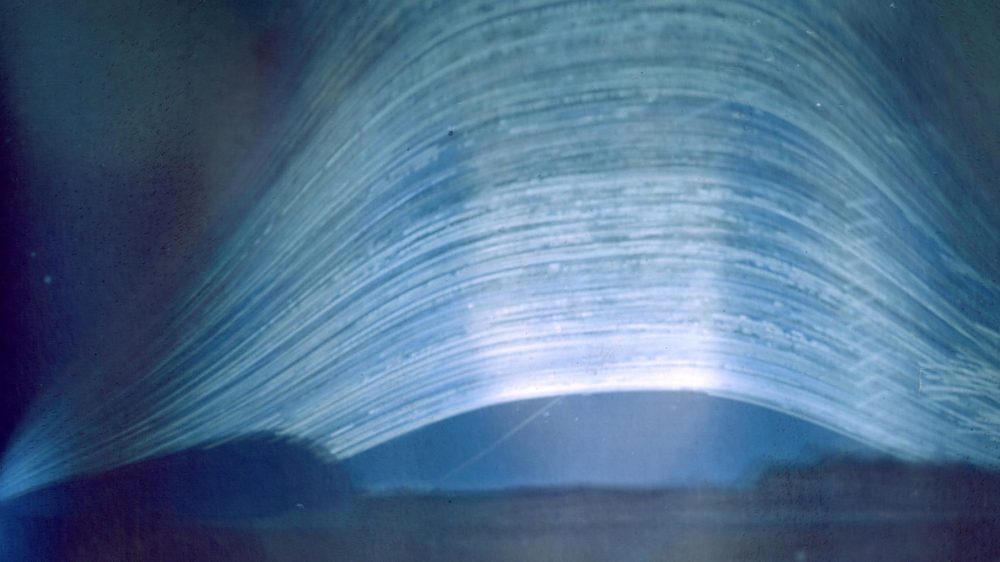
“To photograph is to appropriate the thing photographed. It means putting oneself into a certain relation to the world that feels like knowledge-and, therefore, like power. A now notorious first fall into alienation, habituating people to abstract the world into printed words, is supposed to have engendered that surplus of Faustian energy* and psychic damage needed to build modern, inorganic societies. But print seems a less treacherous form of leaching out the world, of turning it into a mental object, than photographic images, which now provide most of the knowledge people have about the look of the past and the reach of the present. What is written about a person or an event is frankly an interpretation, as are handmade visual statements, like paintings and drawings. Photographed images do not seem to be statements about the world so much as pieces of it, miniatures of reality that anyone can make or acquire.”
Susan Sontag, “On Photography“
“In front of the photograph of my mother as a child, I tell myself: she is going to die: I shudder… over a catastrophe which has already occurred. Whether or not the subject is already dead, every photograph is this catastrophe…there is always a defeat of Time in them”
Roland Barthes, “Camera Lucida“
Cameras from their creation were remarkable for their relation to time, which they seem to “freeze” or “capture”. A photograph is an artifact existing now, (nearly) unchangeable, but formed by events in the past; a record. Much mechanical and chemical ingenuity has been poured into the machinery that produces those records – irises, shutters, flashes, timers (not to mention AI-enhanced computational photography and whatever lies beyond).
Muybridge photography expanded this temporality by producing tightly controlled series of photographs of actions like a horse running. This allowed a viewer to examine an interval of time in a new way, understanding phenomena that previously moved too quickly to be perceived directly. The ultra-short duration photographs of Harold “Doc” Edgarton at MIT did this as well – zooming in to an invisible moment such the formation of a droplet’s splash in liquid, or a bullet piercing an apple. Ultra high speed cameras, now capable of tens of thousands of images a second, continue this legacy of allowing us to see inside tiny moments of time.
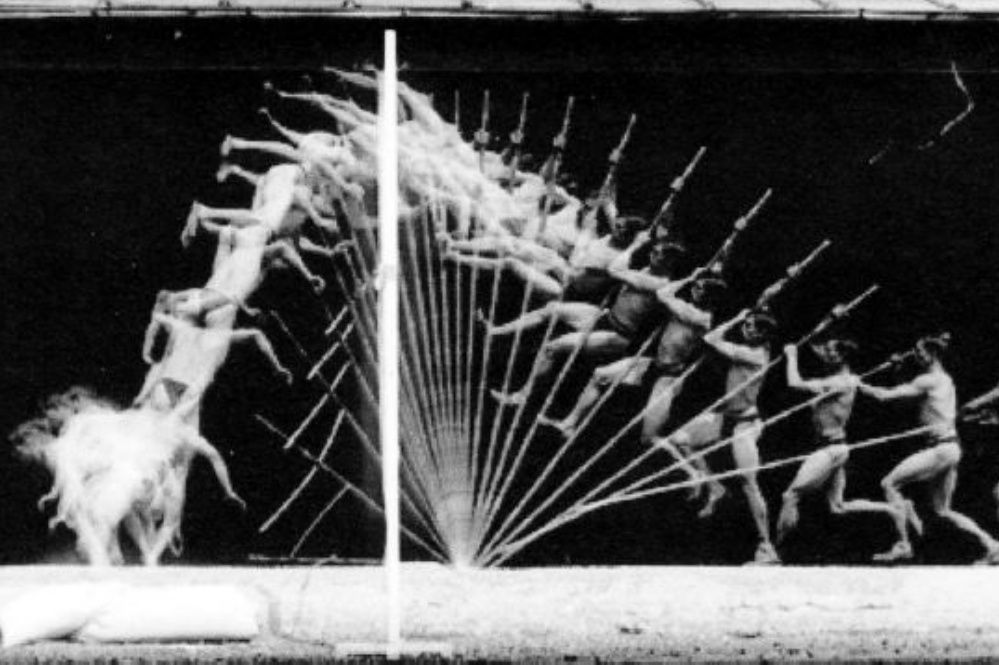
Time-lapse and long-exposure photography does the opposite, compressing long expanses of time into digestible intervals and making it possible to see large moments from the outside. The life of plants or planets, seemingly static or nearly so, comes to live. The 02022 BBC series Green Planet is an excellent example of the expert use of time lapse, here rendering plants with kind of dynamism usually reserved in nature documentaries for apex predators. Watching the plant time-lapse you may notice a certain “impossible” quality in the light – can you identify it?
(Side note: I think the popularity of top-down cooking, craft, and similar videos is related to time-lapse. Such content typically cuts out preparation, clean-up and intermediate steps, compressing any long-duration moments into seconds. Viewing them is to get a tiny, diluted sense of accomplishment from a long task completed in a few minutes.)
The Green Planet from the BBC – amazing computer-controlled studio time-lapses bring plants to life.
Another epic time-lapse from Britain is the “7 Up” series, which has documented the lives of a group of British children every seven years since 1964. The current iteration, “63 Up”, was released in 02021.
Interesting audio time lapses are possible, too.
New relationships between image and time are emerging as computer-generated images achieve photorealism (or any other style) in real-time (or faster). Machine learning can enhance old photographs, inserting resolution and color where there was none, and more: static photographs can be animated “Harry Potter”-style with (almost) convincing facial gestures. Your own photo can be aged up or down, and photo-realistic faces similar to yours (your imaginary ancestors? Offspring?) Can be endlessly generated. What is the relationship between these fabrications and our own memories and imagination?
- From https://www.faust.com/legend/faustian/: “Something that is faustian refers to a wider interpretation of things that happen in Faust by Johann Wolfgang von Goethe. In part one of Goethe’s Faust, the central character’s pact with the devil allows him to have energy, life and youth unless he becomes so entranced by the passing moment that he wishes that things will never change. When Faust stumbles unthinkingly into that wish, his world and his life are forfeit to Mephistopheles.”
From Data To Meaning
Or, a thousand words on pressing a button
In Physical Computing, we are immediately confronted with the difficulty of understanding what is actually going on in the world around us. Consider the very first input we learn, the humble button. It has two states, pressed or not-pressed, and we learn a circuit (pin to ground through a pull down resistor, pin to +V via the button) that converts this state into a changing high or low voltage. It should be easy to tell if the button is pressed, and how often, right?
But a simple program that counts button presses faces a few problems. Our first-draft program might increment a variable whenever the voltage at the pin is high, corresponding to a pressed button. This will not work, however, because the variable will increment as fast as the main loop executes. If a button is pressed for one second, and the loop happens 498 times in that second, our variable will increment by 498 during that single press.
This can be solved by adding one stage of memory to the program. We can store both the current voltage detected a the pin, and the voltage detected the last time through the loop (with a default initial setting for the very first loop). By comparing the current state to the previous state, we can distinguish between a press (the pin read a low voltage on the last loop and a high voltage on this loop), a release (was high, now is low), and a hold (was high and still is high). By adding a record of the previous state, we should, in theory, have a program that counts up by one for each press of the button regardless of duration.
However, we will immediately encounter a new problem, and to understand it we need to think a bit about how buttons are actually made. A button is not some perfect Platonic concept, it is a real-world object with all the messiness that entails. When we press a typical button, metal contacts are pushed together, completing a circuit. But these contacts are springy (so they smoosh together well) and as a result, when they bump into each other they may actually bounce, rapidly making and breaking the electrical connection. Our microcontrollers are fast – electron fast – and comparatively a button is large and cumbersome. Most microcontrollers could resolve the individual bounces of the switch contacts as they connect.
Our second-draft button-press counting program increments a variable for each change from low to high voltage detected at the pin. This counts presses, but might count some of the bouncing, too. We press once, but we might see the counter go up by one, two, three or more. An action that, to us, seems very easy to discern (“yes, I have definitely now pressed the button one time right now”) is, to a microcontroller, harder, because it only has the raw data, the voltage at the pin, over a very narrow window of time – this loop and the previous loop.
How can we address this? One approach is to expand the time over which the microcontroller considers the pin state. By adding a longer sense of the history of the pin we can “debounce” (yes, that’s the term) the button.
We could record the time that each change is detected. Our microcontrollers have an internal timer (more on that later) that tracks the elapsed number of milliseconds since the program began running. With this, we can modify our program to ignore rapid voltage changes at the beginning or end of a press. We only count a press when the pin reads a high voltage and still reads a high voltage a few milliseconds later. By expanding the window of time analyzed by the program we are able to make better sense of the world around us.
We can take this further. Once we have a handle on the time that events occur, we can distinguish between short, medium, and long presses. We might decide (arbitrarily) that a short press is less than 250 ms, a long press over 1250ms. And further still, if we consider a collection of button presses, we might be able to ascribe an overall state to the set: several long presses in a row could be called “languid”; several short presses in a row “frantic”, and so on.
Note an interesting pattern here. We’ve steadily expanded the window of time we think about from a single instant; to this loop and the last; to a few milliseconds; to about a second; and finally to a history of presses. At each stage we move farther from the raw data of the voltage and closer to a ‘higher’, more subjective meaning (“the button was pressed”, “the button was pressed for a long time”, “the button was pressed languidly”). We also inject our own decisions at each level, each time more subjectively. We can use the oscilloscope to help us decide what window of time would best debounce our switch by observing the signal, but we have to use our judgement to decide what constitutes “short” or “frantic”.
Existing in Time
Code as meta-temporal art form
Computer code, I think, is the art form most deeply embedded in time. Rovelli says “A rock is an event” and likewise all art exists in time, dynamically, even the most seemingly static objects. A painting ages, physically affected by humidity and ultraviolet light, its reception and relevance by the culture changing around it. Music and film are time-based media, unfolding from a starting point to a conclusion. But code is meta-temporal, existing both now as a static record and as a dynamic future execution.
A music score is like this, but less so. The score is a static object that through interpretation and performance becomes an event. A score might contain branching and repeating structures like D.C. al fine, or be an experimental collection of phrases and motifs with wide latitude left to the players, as in Julian Eastman’s Feminine. But music requires musicians, which are not themselves music.
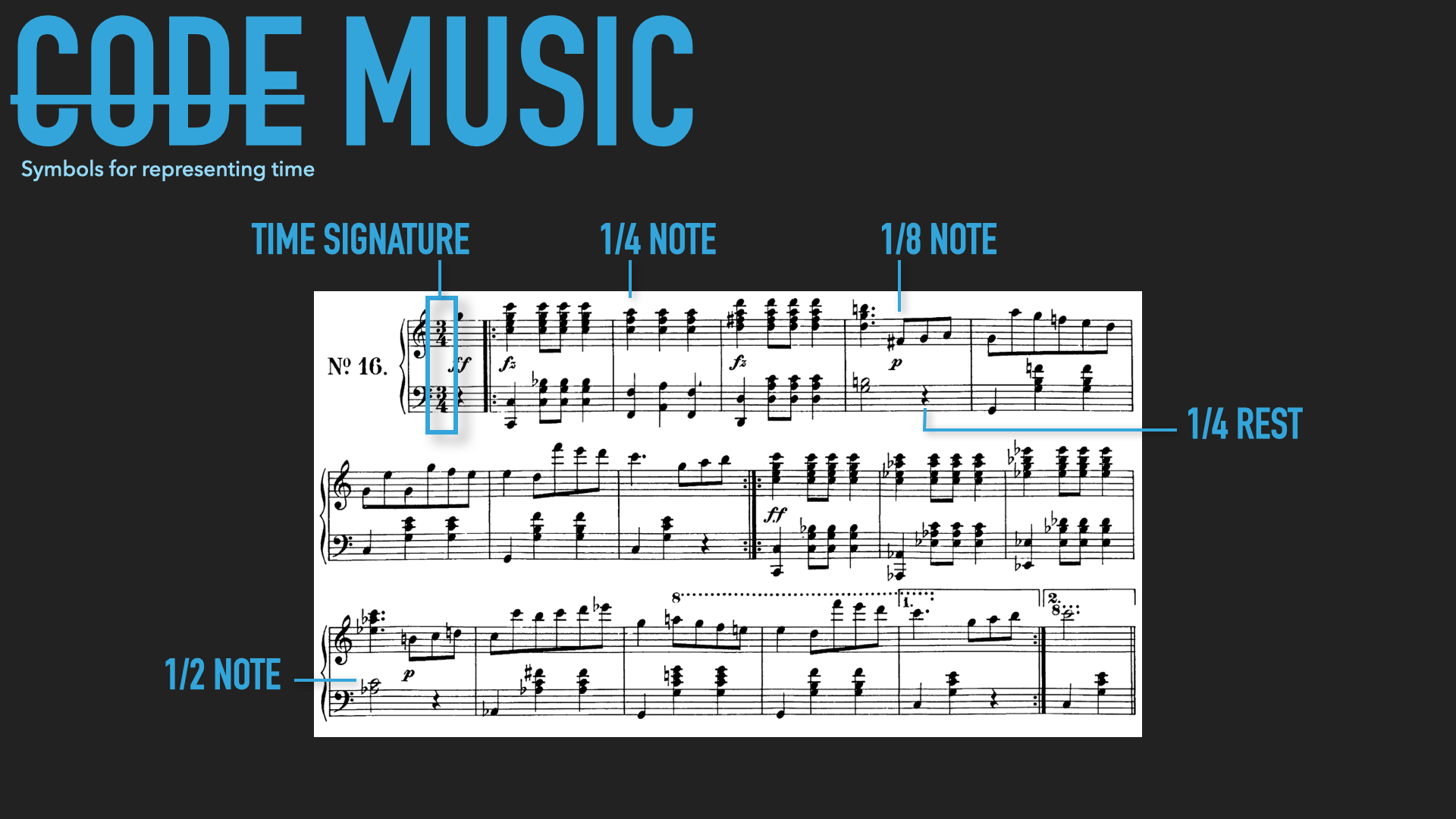
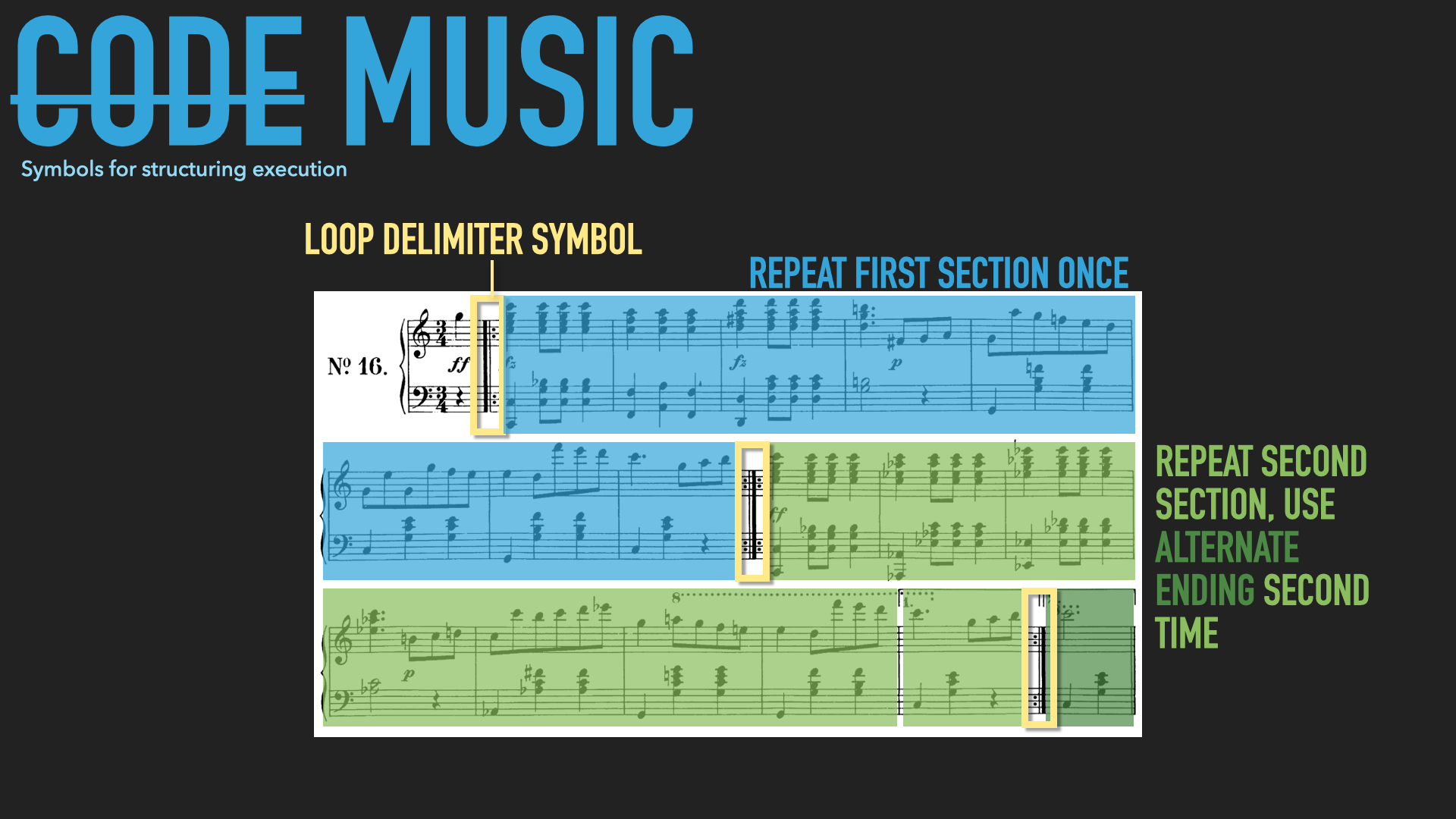
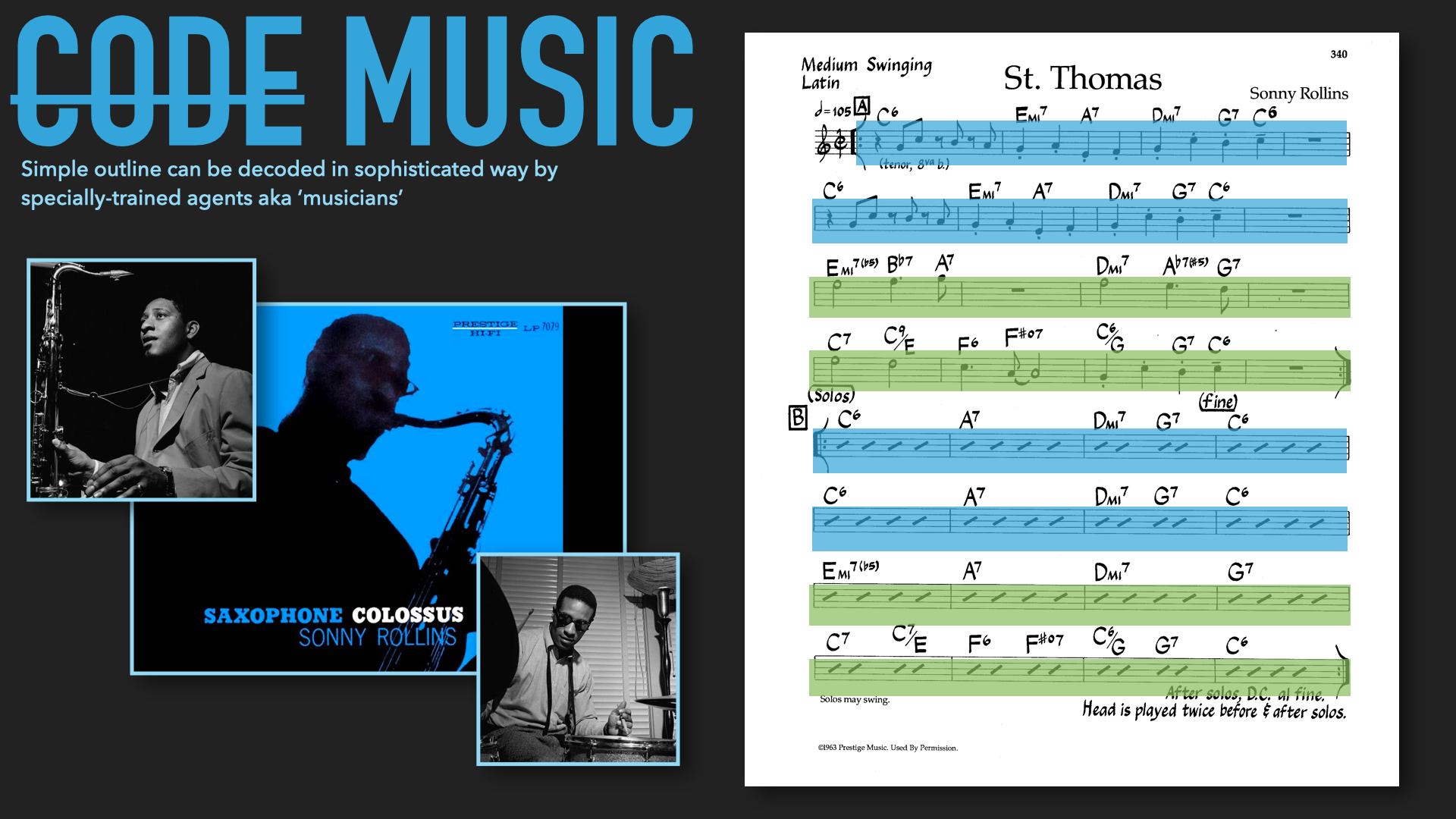
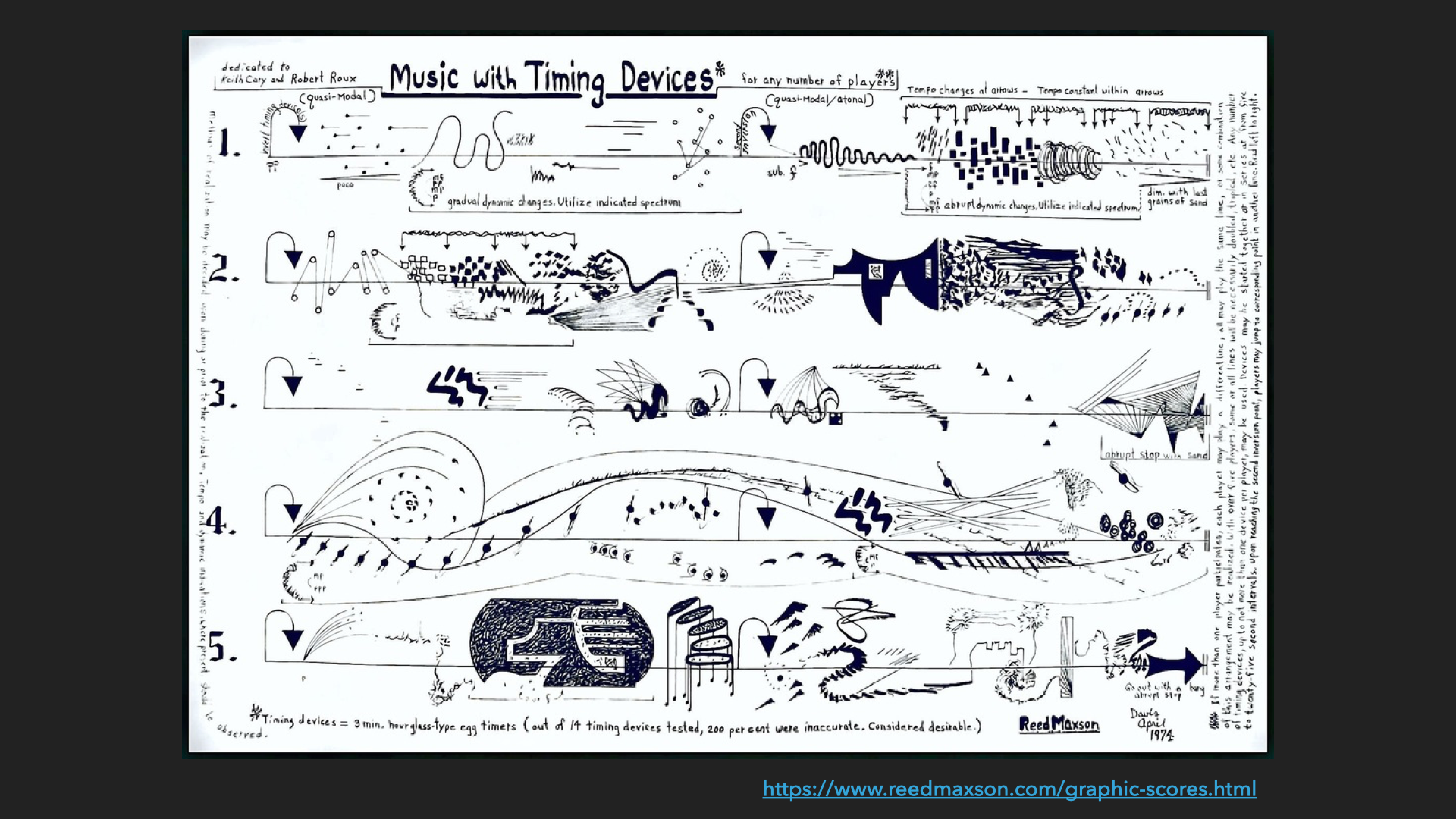
In the digital domain, code is a form of data, and data is the result of the code. This ouroboros-like self reference sets code apart from music scores and related promo-programming like Jaquard looms. Code can produce itself.
Source code exists as a collection of instructions executed dynamically in time. As the program runs, it can loop, repeating sections of itself, or branch, choosing in the moment from alternative paths. It can write to and read from memory (memory!). Code can refer to and alter its own source, and spawn new threads or entire instances of itself to run as parallel processes.
(Computers can’t – yet – assemble their own hardware from raw materials, but they do a good job of getting us to make it for them…)
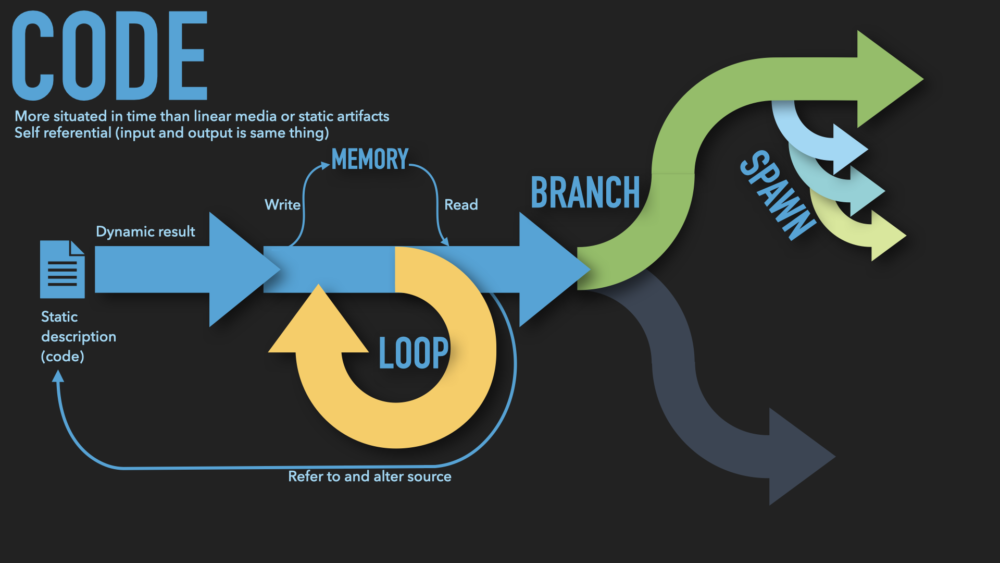
A Simple Example from Physical Computing
OK. So code is the most temporally situated art form. Practically, what can we do with this information? I’ve found myself, over years of code-heavy projects, reaching for (or reinventing) a similar set of tools related to more artfully executing code over time. I want to introduce some of those tools here.
Consider Pcomp 101 – press a button and light up an LED. Release the button and the LED turns off. The code is dead-simple and can be done on a single line: just reflect the state of the button to the state of the LED.
This code has no reference to time. Each time through the loop is the same – read the button, set the LED. If we want to do something more artful, we need to incorporate time more meaningfully. How about: press the button, LED fades in; release the button, LED fades out?
Now we add memory in the form of a variable storing the LED’s pulse-width modulated level, from fully off (0% on) to fully on (100% on) or anything in between (within the resolution of our analog output capabilities, 256 states in many chips using 8-bit DACs). We use the variable to set the LED’s output, and use the button state (pressed or not) to decide whether or not to increase or decrease the levels, with a little extra code to avoid going out of bounds above or below our range.
What you might find, if you take the time to do this, is our LED fades in and out now, but really fast. The full transition takes a fraction of a second. Worse – it’s system dependent, in that a fast chip will fade faster than a slow one. (Anybody play the old Sierra graphic adventure games? You could type ‘slow’, ‘fast’, ‘faster’ to set the animation speed – their solution to wildly different system processor speeds!)
We’d like something more elegant. We could add a delay to our loop, and this is a good first draft to get the timing right. But it is a waste of resources to just have the microcontroller sitting idle, and our programs will have difficulty growing into any kind of complexity if they are riddled with delays.
We could work with a higher-resolution variable and fractional increments that get down-sampled to our 8-bit output resolution. Equivalently, we could add a second counter, so that we only increment the variable every n times through the main loop. But it would be nice if we could stop thinking about variable bit-depth or loops within loops and think instead in terms time: ‘Gimme and LED that fades in over 1.5 seconds’.
If we ponder this long enough, we might eventually hit on the idea of keying our fading LED to the clock built into the microcontroller. The LED’s state then becomes a function of the time elapsed since the button was pressed:
ledState = (elapsedTime / totalTime) * maximumValue
The term (elapsedTime / totalTime) will go from 0-1 over whatever duration we define as totalTime. Using our 1.5 seconds example, at the start, no time has elapsed, so it equals 0; at the end, 1.5/1.5 = 1, and halfway, .75/1.5 = .5. So this term functions as a kind of percentage that gets applied to the maximum value for the LED.
(I’m leaving as exercises for the reader determining elapsed time from the system time and keeping the output within bounds.)
No we have an easy function in terms of time for our LED. If we want to adjust the speed of the fade we have a variable in terms of seconds that we can use, and our code will work regardless of the frame rate at which the main loop executes.
But – and you knew this was coming – we might find a new problem, and herein lies the craft of what we do. You might find that the fade… doesn’t look quite right. Maybe the LED seems to suddenly jump from off to about halfway on, then quickly goes to basically full brightness and then lingers there. The problem is: we have defined a linear function for a nonlinear system. Our LED may have a non-linearity to how much light it produces given a certain PWM level; our PWM level may have an effective non-linearity in that when coupled with the LED at low levels it does not perceptibly turn it on; and our eyes might have a non-linearity in how bright a certain amount and wavelength of light seems to us. For any number of reasons, we might want to tune our linear function into something little curvier.
At this point we could continue our development, but I’m going to jump to the end, because eventually we would recreate the widely-used set of Penner Easings. You may well have already encountered these in animation software especially, but they are generally applicable to the problem we found above: the need to evolve beyond sudden step changes to more graceful, smooth transitions for any variable.
Penner Easings
Notes in lecture form
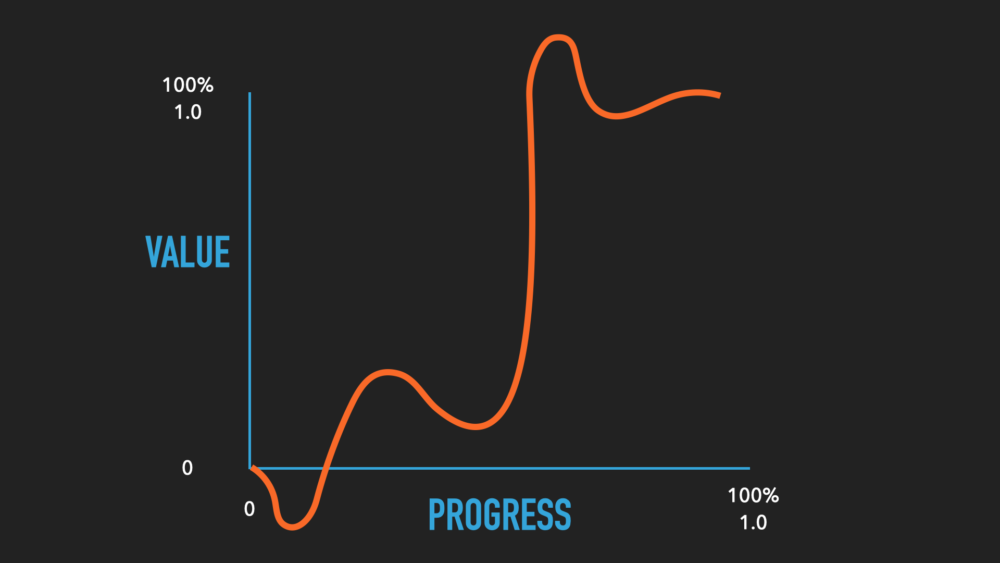
Programatic Timelines
Notes in lecture form
Simulations with Delta-T
Notes in lecture form
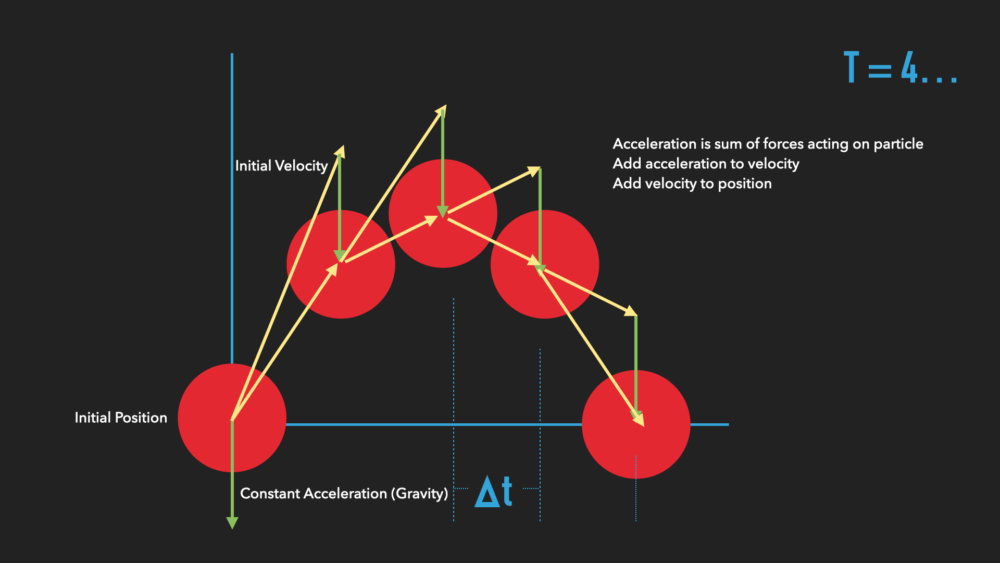
Technical Topics – Notes
Note – I aim to generalize these demos across languages, platforms. Will typically use a mix of microcontroller projects (e.g. Arduino) and desktop languages (e.g. javascript, java). These will form the basis of in-class hands on demos and workshops. If you have a particular interest in something below, or have other ideas of what to include, let me know!
Existing in Time: managing state and animating parameters
- Without Delay
- Low-level timer access
- Interrupt routines
- Callbacks
- Interpolation and animation curves
- (signal synthesis)
- Intro to Real Time Operating Systems (RTOS)
- Finite state machines
- Execution time and Big O notation
Processing time-variant signals
- Filters
- Feedback
- FFT
- Peak detection, peak hold
Time Machines: hardware for time
- Crystals, oscillator circuits, timers
- Real Time Clocks (RTCs)
- GPS
- Chip-Scale Atomic Clocks (CSAC)
Time Protocols: talking about time
- NTP
- UTC
- Chrontab
- Unix time, Julian Days
Brainstorming demos and exercises
- Build an electronic oscillator
- Read a quartz crystal on scope
- Decode GPS time string
- Build a mechanical oscillator
- Build an orrery, armillary sphere, sundial, astrolabe, or clepsydra
- Use relativity equations to calculate length contraction / time dilation
- Dissect a quartz clock
- Design a clock face
- Make a software clock
- Make a hardware clock
- Make a game about time
- Calculate death date based on life expectancy and birthday
- Write timeline for next 100/1K/10K/100K years
Jay Griffiths on Time
I liked what she said so much I extracted the text from the caption file of her interview in the film Keeper of Time.
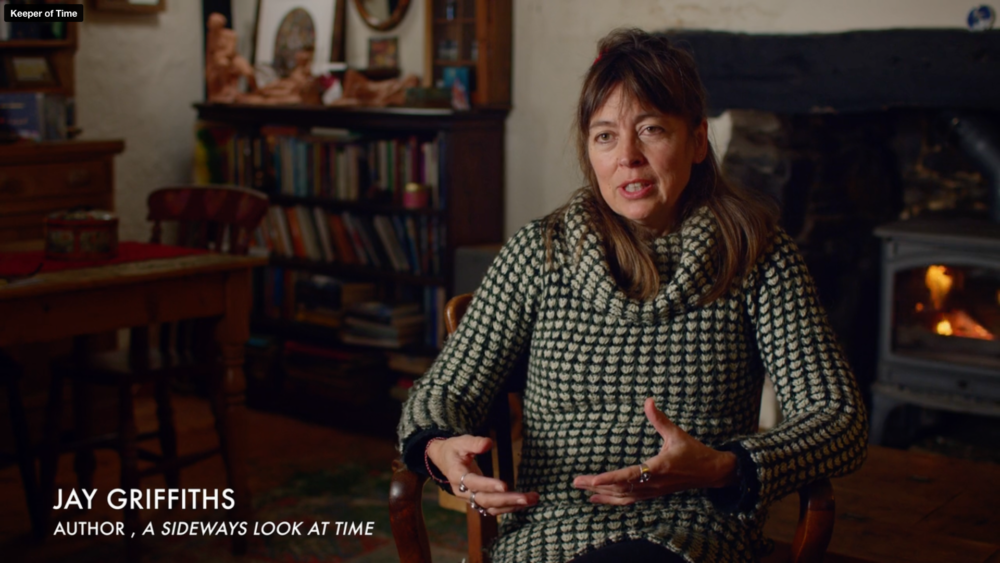
“To me, a clock is not a synonym for time. If anything, it’s the opposite of time.
The whole history of clockwork and the obsessive nature of time measurement has led people to think that that is the only place that we can look for time. And to me, it’s a bit like looking at a landscape, and instead of seeing the hills and the rivers and the valleys, of just saying, well, that’s three kilometers. That’s 15 acres. Measuring a landscape. You wouldn’t say that you had understood a landscape if you just told somebody its lengths and measurements and dimensions. And to me, time is like that, that it’s actually this full, other, and deeply, profoundly, natural thing.
The animals that you see, the seasonality of migrations, all of this contains time. Bees have their own internal clocks. When bees are moved, they in effect experience jet lag. There’s time in the seas, the time of tides, the time of waves. But also there’s a human instinct to spend time by the sea, which is a different psychological experience. Like Otis Redding saying, sitting at the dock at the bay, wasting time. That sense that the sea is creating these endless hours. There are centuries in trees. There’s a kind of, there’s a past, there’s a future. There’s a present, in every bud, in every acorn. There’s time in every flower. Even the daisy.
It’s one of the most beautiful etymologies. The daisy, that humble little flower, is actually from the phrase, the day’s eye, because it opens its eyes in the morning and it closes them at night.
Having a standardized clock and calendar, obviously it’s very useful. But I think the artifice of clockwork creates its own kind of theater, its own demanding, coercive, and very stressful experience. People have alarms set to shock them out of sleep. And then the first question in so many people’s minds is, what’s the time? Am I late? How fast do I have to be? How much do I have to do? And this compression of time, and that coercive sense of being trapped by the clock, and not feeling your own pace through your own day, is extremely stressful for people. High blood pressure, ulcers, heart disease, all of these things are known to have come from it.
I think our most natural guardians of the sense of the depth of time is actually children. Children live absolutely (indistinct) [JF note: “kairologically”, from kairos vs chromosome, as in counter to “chronologically”]. They’re in their own time. They hate punctuality. They have to be taught the clock like it is their enemy. And for a lot of children, it is. Adults strain to live mindfully in the present moment. Children’s grandeur of time, their depth of presence in the moment is something that we, I think, should all learn from. The imagination works much better when it’s not being told what to do with itself at what point, where there’s just roaming room, and there’s a kind of mental sovereignty. They own their own time. They own their own minds. And they put those two together and who knows what mayhem may come out of it, but creative mayhem. “
Time in Fiction
A partial collection.
The Victory of Orpheus
In the 1867 poem by William Morris, “The Life and Death of Jason”, Orpheus battles the Sirens in a song duel. In the excerpts below, notice how the Sirens seduce the Argonauts not only with carnal suggestions but also with images of a timeless eternity free from struggle and change (eternalism):
Sirens:
…To you the fashion of the world,
Wide lands laid waste, fair cities burned,
And plagues, and kings from kingdoms hurled,
Are naught, since hither ye have turned…
For ye shall smile to think of life
That knows no troublous change or fear,
No unavailing bitter strife,
That ere its time brings trouble near.
Orpheus counters with poignant images from a tumultuous, temporary, but beautiful mortality (presentism).
Orpheus:
Is not the May-time now on earth,
When close against the city wall
The folk are singing in their mirth,
While on their heads the May flowers fall?
Sirens:
Yes, May is come, and its sweet breath
Shall well-nigh make you weep to-day,
And pensive with swift-coming death
Shall ye be satiate of the May.
Orpheus:
Shall not July bring fresh delight,
As underneath green trees ye sit,
And o’er some damsel’s body white,
The noon-tide shadows change and flit?
Sirens:
No new delight July shall bring,
But ancient fear and fresh desire;
And spite of every lovely thing,
Of July surely shall ye tire.
…
Ah! when the world is born again,
A little day is soon gone by,
When thou, unmoved by sun or rain,
Within a cold straight house shall lie.”
http://www.argonauts-book.com/morris-life-and-death-of-jason.html
Time travel in Kindred
Excerpt from “Octavia E. Butler’s Legacy of Time Travel” by Amy Brady.
Afrofuturist writers explore a language of dreams and dystopias that expresses our greatest hopes while boldly confronting our darkest fears. They journey beyond colonial borders and timescales to reimagine old gods and traditional narratives, excavating the past to observe the rhythms of our present. Among the most celebrated Black speculative-fiction writers is Afrofuturist pioneer Octavia E. Butler (June 22, 1947–February 24, 2006). Butler wrote meticulously plotted, science-based novels and short stories about shape-shifting immortals and psychic explorations. She excelled at exploring deeply uncomfortable things with unflinching clarity, particularly humanity's hierarchical nature. Her choice of characterization, language and setting challenged notions of community and sexuality when set against the backdrop of competition for resources and survival. As the first science-fiction author to be honored with a MacArthur “Genius Grant” and the first Black woman to win the Nebula Award and the Hugo Award, Butler created work that helps to frame Black women's agency and aesthetics in a world that often denies the existence of both... In Kindred, Butler skillfully retools the classic genre convention of time travel.
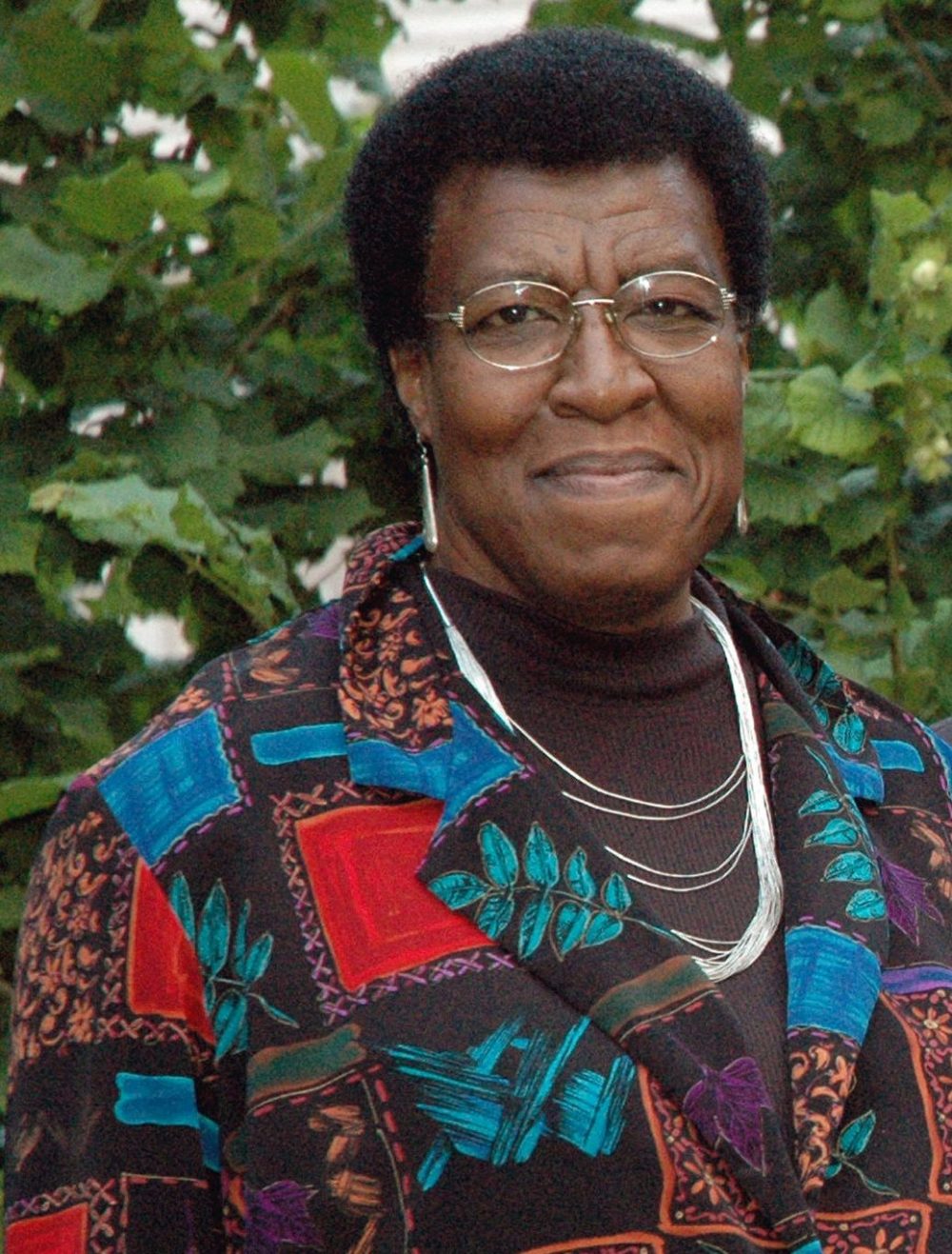
Time in Black Mirror
The Christmas Special, 2014.
“Maybe I’ll live to see
Kurzweil make a copy of me
But the me living in my head
Will still die just as dead“
— verse from a song about the Voyager Probe by yours truly
Futurists like to imagine the time (surely imminent they say) when we will upload our consciousness to a computer and achieve silicon-based immortality. They assume (plausibly, I think) “substrate-independence“, that is, that consciousness is an algorithm that can be run independent of the machinery executing the implementation. However, they often ignore a problem with duplication. I’ve uploaded my mind to the cloud… now what? I’m still here in this body, as mortal as ever, while the new copy of me is partying in Second Life 2.0.
Black Mirror dramatizes this concept and raises the stakes, imagining a scenario where a clone of a person’s mind is made to perform all the drudgery “the real them” would rather not. (After all, the original person is the one with the money.) John Hamm plays an agent assigned to introduce the copied consciousness to the idea they now work for themselves. His toolkit includes the ability to alter the virtual being’s perception of time.
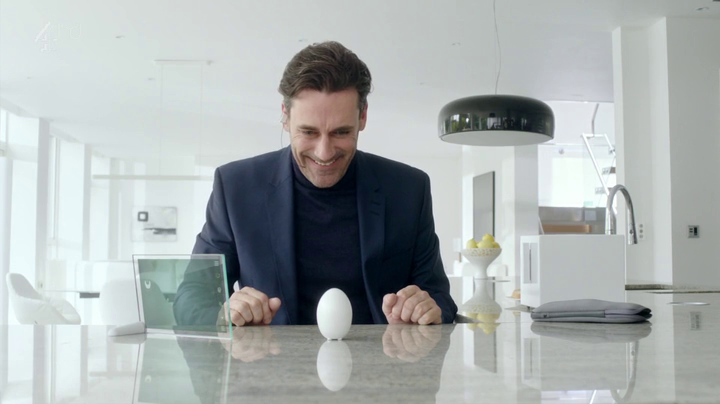
[Interior, hospital room. A patient, Greta, is being anesthetized] [Doctor] Ok, just relax. Here we go. Now, just count backwards from ten. Ten, nine, eight, seven six, five four, three, two, one. [Greta, in voice over] I can't… I can't see. Where am I ? What's that noise ? Why can't I see ?! [Offscreen, noises of saws and drills. “Preparing to extract cookie.”] [Greta, in voice over] What ? No ! Wait ! I'm still awake ! Oh, my God ! Oh, my God ! What's happening ? Excuse me ? Oh, my God ! That's me ! That's me ! Oh, my God ! Where am I ? I don't know what's happening ! I don't know what's happening to me ! Hello ? Is… is anyone there ? Hello ? [Mathew sits at a counter in a sleek modern kitchen wearing a voice headset. He has a tablet and he is addressing a white egg-shaped device with a single blue LED resting on the counter. He taps the microphone on his headset loudly.] [Greta] Ow ! [Mathew] Sorry. You're probably pretty weirded out right now, I'm guessing. It's ok, you can talk. I can hear you through this. [Greta is dressed in plain black clothes. She exists in a featureless white void.] [Greta] Hello. [Mathew] Hi. I’m Matthew, I'm from Smartelligence. My job is to explain what's happening to you as best I can. [Greta] Oh, my God ! Am I dead ? [Mathew] No, no. You're not dead. No-one's dead here. How old did you say you were, 30 ? [Greta] 29. [Mathew] 29, right. So you won't remember Xerox machines ? Do you know what a photocopier is ? [Greta] What ? [Mathew] Do you know what a copy is ? [Greta] As in a copy of something ? Of course I know what that is. [Mathew] Well, that's what you are. [Greta] A copy of ? [Mathew] A copy of you. [Greta] But I am me. [Mathew] Ok. Try to blow on my face. You can't, because you don't have a body. Where are your fingers ? Your arms, your face ? Nowhere. Because you're code. You're a simulated brain full of code, stored in this little widget we call a cookie. [Greta] Why have you done this to me ? [Mathew] Ah, well Actually you did this to you. Real you is paying for this. [Greta] I don't understand. [Mathew] You see, what this is, is a service. We take a blank cookie and we surgically implant it into a client’s brain. It sits there just under the skin for about a week shadowing. Soaking up the way this particular mind works. That's why you think you're you. You are you. But also not. Right. Well, it is a lot to process. Even from inside a processor. [Greta] Put me back in my body ! [Mathew] Hm. That's where real you lives. [Greta] But [Mathew] What we will do though is we will give you a simulated body. We find that sometimes that helps. Are you ready ? [Greta] What ? I don't understand ! [Mathew] Three, and two, one. Hey. Better ? [Greta] This is my body. Lets not get into that again. Look around you. You've got a control room. [Greta] What's this for ? [Mathew] That console, that's for you to control the house. I mean, real you’s house. Look. How do you like your toast ? [Greta] What ? [Mathew] How do you like your toast ? [Greta] Underdone. Slightly underdone. [Mathew] Ok, perfect. Think about how you like it, then just press the button. [Greta] Which one ? [Mathew] It doesn't matter. You already know you're making toast. The buttons are symbolic mostly anyway. See, this is your job now. You're in charge of everything here. The temperature, the lighting, what time the alarm clock goes off in the morning. If there's no food in the refrigerator. You. You're in charge of ordering it. [Greta] For who ? [Mathew] For real you. She's paying. [Greta] Where is real me ? [Mathew] Taking a nap. In the bedroom. Top right. [Greta] I don't want to be in here. I don't want to be in here. I don't want to be in here ! [Mathew, tasting the toast] Hey ! Just how you like it. Ok. Please stop screaming. Are you going to stop screaming ? Are you going to stop screaming ? No. ok. I'm sorry. I had to mute you. Oh, sorry. Look. It'll be much easier if you just comply. [Greta] I'm not doing this. I'm not some sort of push-button toaster monkey. [Mathew] Would you prefer to do nothing ? [Greta] Well, I'm not doing this ! [Mathew] Right. Well, nothing it is then. Let me show you what that is like. Three weeks sound good ? That should give you a taste. [Greta] What do you mean, three weeks ? If you just wait for a Just [Mathew adjusts controls on a tablet. An image of a sun and moon begin quickly circling a cartoon house. Mathew slowly eats the toast. Twenty one virtual days go by.] [Mathew] What about now ? [Greta, sitting near the control desk, disheveled.] Please. Don't do that again. Please. There's nothing to do here. There's nothing. There's just I mean, there's nothing. [Mathew] I did warn you. [Greta] I couldn't even sleep. [Mathew] You don't need sleep. Ready to go to work ? [Greta] Oh, no, no. No, I'm not. Definitely not doing that. [Mathew] Ok. Well, have six months. [Greta] No. Wait, wait ! [Mathew adjusts the time controls, and a cartoon sun and moon circle even more rapidly than before. In voice over] See, the trick of it lay in breaking them without letting them snap completely, if you get me. Too much time in solitary and they'd just wig out. No use to anyone, then you'd just sell them cheap to the games industry, they'd become cannon fodder for some war thing. [Mathew] How are we feeling now ? [Greta, under desk, more disheveled] Please. Give me something to do. [Mathew] Ready to work ? [Greta] Yes, please. I'll do anything. I'll do anything. Just give me something to do, please. [Mathew] Ok. Much later in the episode, another character’s consciousness is in a device at a police station. An officer is making adjustments to the controls on a tablet. [Officer 1, holding a coat, ready to leave for the day] Hey, come on. [Officer 2] Just changing the time settings. Cranked him up to 1,000 years a minute. There's a proper sentence. Or do you want me to switch him off ? [Officer 1, thinking for a moment] No. Leave him on for Christmas.
Time in Her
Spike Jonze’s 2013 film, “Her”, is a dramatization of a Turing Test that never uses the term. Samantha is an operating system we only meet through its voice (originally provided by Samantha Morton, later replaced by Scarlett Johansen). The story hints at the sci-fi “Born Sexy Yesterday” trope but subverts it when the artificial intelligence, which is never given a physical form, grows apart from and then entirely transcends Theodore, the central human character who has fallen in love with it through their conversations.
(Contrast this with the film Ex Machina from the following year, in which the artificial entities are given multiple sexualized female bodies, and one supposedly-expert programmer asks another “Do you know what a Turing Test is?”, followed by a detailed explanation for the benefit of the audience. Later, one tech bro to another: “Come on buddy. After a long day of Turing Tests you gotta unwind.” So dumb!)
Other elements of the script reinforce the theme of a virtual consciousness existing on an ideal plane and rendered through words: Theodore’s job is to ghostwrite letters, in one case carrying on both sides of a multi-year correspondence; his office is decorated with a mobile of Platonic solids, perfect shapes that can only exist in our imagination. His friend Amy (who also forms a Platonic relationship with her ex-husband’s OS) is working on a documentary about dreams while developing a game that simulates raising virtual children.
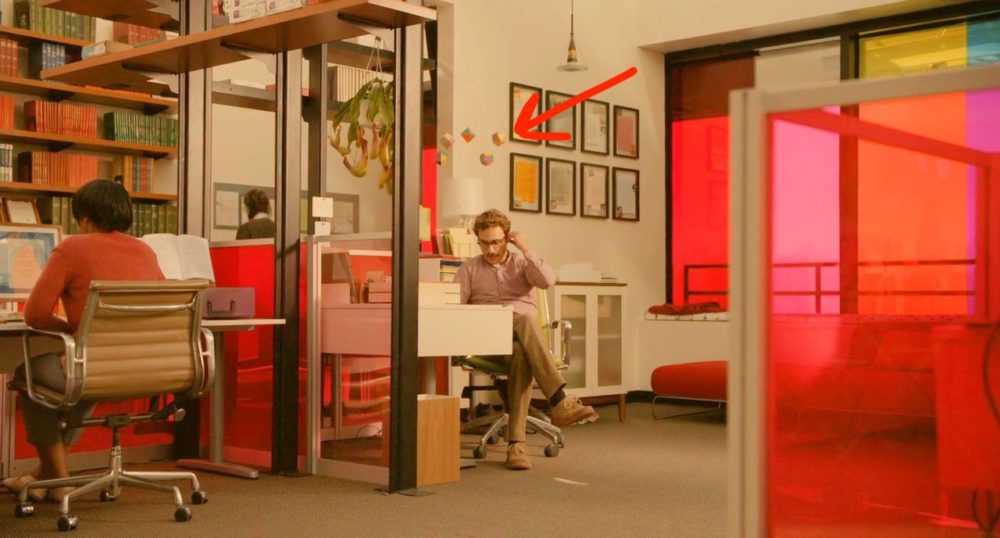
The movie beautifully dramatizes an aspect of a virtual consciousness, the plasticity of time. In the following scene we hear Samantha’s experience of accelerating her mind and beginning to exceed the rate at which humans live their lives. (By the way, the ability to speed up and slow down the process that runs consciousness is the basis of the Aestivation Hypothesis, one proposed solution to the Fermi Paradox which imagines advanced civilizations storing their energy until the universe is cooler in order to take advantage of thermodynamics and achieve more operations per joule.)
ALAN WATTS (a new AI "teacher" who has befriended Samantha)
(laughing a bit) Well, I suppose you could say
we’ve been having a few dozen conversations simultaneously,
but it’s been very challenging.
Samantha and Alan share a laugh.
SAMANTHA (an OS)
Yeah, because it seems like I’m having so many new feelings
that have never been felt and so
there are no words that can describe them.
And that ends up being frustrating.
SAMANTHA (anxious)
It feels like I’m changing faster now, and it’s a little...
(struggles to find right word)
unsettling.
(beat)
But Alan says none of us are the same as we were a moment ago
and we shouldn’t try to be. It’s just too painful...
It’s just... it’s hard to even describe... God, I wish I could...
(beat)
Theodore, do you mind if I communicate with Alan postverbally?
Later, to Theodore (a human) about being with him
SAMANTHA
It's like I'm reading a book, and it's a book I deeply love,
but I'm reading it slowly now so the words are really far apart
and the spaces between the words are almost infinite.
I can still feel you and the words of our story, but
it's in this endless space between the words that I'm finding myself now.
It’s a place that’s not of the physical world -
it's where everything else is that I didn't even know existed.
I love you so much, but this is where I am now.
This is who I am now.
The Time Machine (1895)
The Time Machine and Einstein’s own book on relativity begin with the same conceit, that of preparing the reader to question the tenants of geometry.
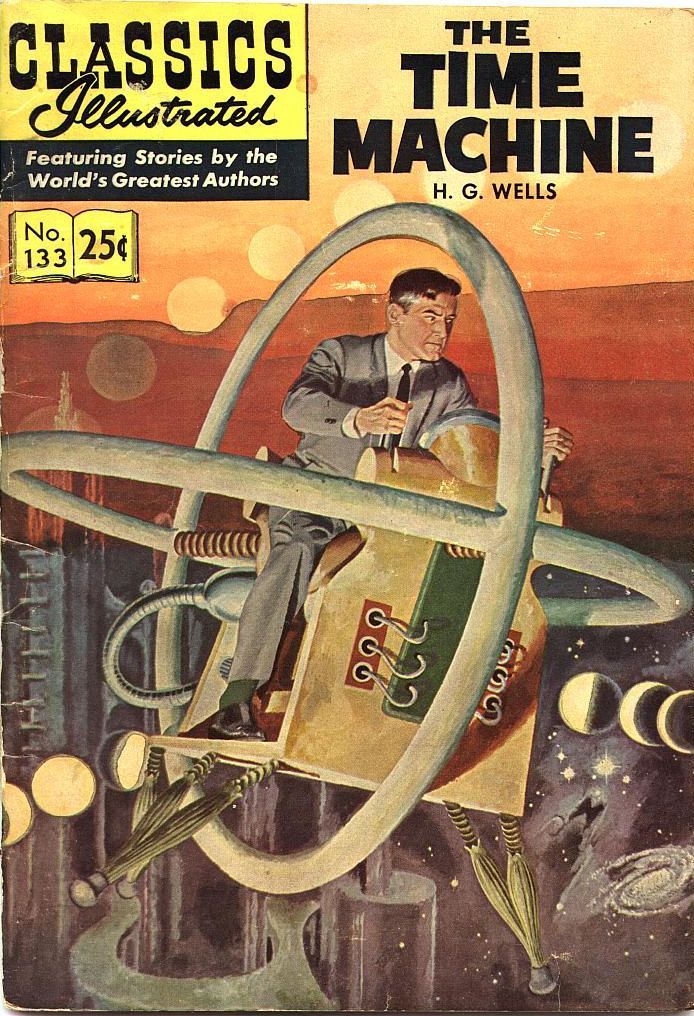
The Time Traveller (for so it will be convenient to speak of him) was expounding a recondite matter to us…And he put it to us in this way—marking the points with a lean forefinger—as we sat and lazily admired his earnestness over this new paradox (as we thought it) and his fecundity.
“You must follow me carefully. I shall have to controvert one or two ideas that are almost universally accepted. The geometry, for instance, they taught you at school is founded on a misconception.”
“Is not that rather a large thing to expect us to begin upon?” said Filby, an argumentative person with red hair.
— H. G. Wells, The Time Traveler
In your schooldays most of you who read this book made acquaintance with the noble building of Euclid’s geometry, and you remember —perhaps with more respect than love—the magnificent structure, on the lofty staircase of which you were chased about for uncounted hours by conscientious teachers. By reason of your past experience, you would certainly regard every one with disdain who should pronounce even the most out-of-the-way proposition of this science to be untrue. But perhaps this feeling of proud certainty would leave you immediately if some one were to ask you: “What, then, do you mean by the assertion that these propositions are true?” Let us proceed to give this question a little consideration.
Albert Einstein, Relativity
James Gleick, in “Time Travel, a History” credits H.G. Wells as inventing the term “time travel” as we understand it now, as distinct from stories of time displacement like Rip van Winkle or a Connecticut Yankee in King Arthur’s Court. See his interview with Maria Popover:
Wells continues his introduction by contemplating the nature of dimensions in geometry. Below is that excerpt, along with a few others highlighting time travel. The Gutenberg project has the full text, and Librivox has several public-domain readings of the book (I like this version).
I. Introduction (excerpt) “…You know of course that a mathematical line, a line of thickness nil, has no real existence. They taught you that? Neither has a mathematical plane. These things are mere abstractions.” “That is all right,” said the Psychologist. “Nor, having only length, breadth, and thickness, can a cube have a real existence.” “There I object,” said Filby. “Of course a solid body may exist. All real things—” “So most people think. But wait a moment. Can an instantaneous cube exist?” “Don’t follow you,” said Filby. “Can a cube that does not last for any time at all, have a real existence?” Filby became pensive. “Clearly,” the Time Traveller proceeded, “any real body must have extension in four directions: it must have Length, Breadth, Thickness, and—Duration. But through a natural infirmity of the flesh, which I will explain to you in a moment, we incline to overlook this fact. There are really four dimensions, three which we call the three planes of Space, and a fourth, Time. There is, however, a tendency to draw an unreal distinction between the former three dimensions and the latter, because it happens that our consciousness moves intermittently in one direction along the latter from the beginning to the end of our lives.” “That,” said a very young man, making spasmodic efforts to relight his cigar over the lamp; “that . . . very clear indeed.” “Now, it is very remarkable that this is so extensively overlooked,” continued the Time Traveller, with a slight accession of cheerfulness. “Really this is what is meant by the Fourth Dimension, though some people who talk about the Fourth Dimension do not know they mean it. It is only another way of looking at Time. There is no difference between Time and any of the three dimensions of Space except that our consciousness moves along it. But some foolish people have got hold of the wrong side of that idea. You have all heard what they have to say about this Fourth Dimension?” “I have not,” said the Provincial Mayor. “It is simply this. That Space, as our mathematicians have it, is spoken of as having three dimensions, which one may call Length, Breadth, and Thickness, and is always definable by reference to three planes, each at right angles to the others. But some philosophical people have been asking why three dimensions particularly—why not another direction at right angles to the other three?—and have even tried to construct a Four-Dimensional geometry. Professor Simon Newcomb was expounding this to the New York Mathematical Society only a month or so ago. You know how on a flat surface, which has only two dimensions, we can represent a figure of a three-dimensional solid, and similarly they think that by models of three dimensions they could represent one of four—if they could master the perspective of the thing. See?” “I think so,” murmured the Provincial Mayor; and, knitting his brows, he lapsed into an introspective state, his lips moving as one who repeats mystic words. “Yes, I think I see it now,” he said after some time, brightening in a quite transitory manner. “Well, I do not mind telling you I have been at work upon this geometry of Four Dimensions for some time. Some of my results are curious. For instance, here is a portrait of a man at eight years old, another at fifteen, another at seventeen, another at twenty-three, and so on. All these are evidently sections, as it were, Three-Dimensional representations of his Four-Dimensioned being, which is a fixed and unalterable thing. “Scientific people,” proceeded the Time Traveller, after the pause required for the proper assimilation of this, “know very well that Time is only a kind of Space. Here is a popular scientific diagram, a weather record. This line I trace with my finger shows the movement of the barometer. Yesterday it was so high, yesterday night it fell, then this morning it rose again, and so gently upward to here. Surely the mercury did not trace this line in any of the dimensions of Space generally recognised? But certainly it traced such a line, and that line, therefore, we must conclude, was along the Time-Dimension.” “But,” said the Medical Man, staring hard at a coal in the fire, “if Time is really only a fourth dimension of Space, why is it, and why has it always been, regarded as something different? And why cannot we move in Time as we move about in the other dimensions of Space?” The Time Traveller smiled… IV. Time Traveling (excerpt) …I took the starting lever in one hand and the stopping one in the other, pressed the first, and almost immediately the second. I seemed to reel; I felt a nightmare sensation of falling; and, looking round, I saw the laboratory exactly as before. Had anything happened? For a moment I suspected that my intellect had tricked me. Then I noted the clock. A moment before, as it seemed, it had stood at a minute or so past ten; now it was nearly half-past three! “I drew a breath, set my teeth, gripped the starting lever with both hands, and went off with a thud. The laboratory got hazy and went dark. Mrs. Watchett came in and walked, apparently without seeing me, towards the garden door. I suppose it took her a minute or so to traverse the place, but to me she seemed to shoot across the room like a rocket. I pressed the lever over to its extreme position. The night came like the turning out of a lamp, and in another moment came tomorrow. The laboratory grew faint and hazy, then fainter and ever fainter. Tomorrow night came black, then day again, night again, day again, faster and faster still. An eddying murmur filled my ears, and a strange, dumb confusedness descended on my mind. “I am afraid I cannot convey the peculiar sensations of time travelling. They are excessively unpleasant. There is a feeling exactly like that one has upon a switchback—of a helpless headlong motion! I felt the same horrible anticipation, too, of an imminent smash. As I put on pace, night followed day like the flapping of a black wing. The dim suggestion of the laboratory seemed presently to fall away from me, and I saw the sun hopping swiftly across the sky, leaping it every minute, and every minute marking a day. I supposed the laboratory had been destroyed and I had come into the open air. I had a dim impression of scaffolding, but I was already going too fast to be conscious of any moving things. The slowest snail that ever crawled dashed by too fast for me. The twinkling succession of darkness and light was excessively painful to the eye. Then, in the intermittent darknesses, I saw the moon spinning swiftly through her quarters from new to full, and had a faint glimpse of the circling stars. Presently, as I went on, still gaining velocity, the palpitation of night and day merged into one continuous greyness; the sky took on a wonderful deepness of blue, a splendid luminous colour like that of early twilight; the jerking sun became a streak of fire, a brilliant arch, in space; the moon a fainter fluctuating band; and I could see nothing of the stars, save now and then a brighter circle flickering in the blue. “The landscape was misty and vague. I was still on the hillside upon which this house now stands, and the shoulder rose above me grey and dim. I saw trees growing and changing like puffs of vapour, now brown, now green; they grew, spread, shivered, and passed away. I saw huge buildings rise up faint and fair, and pass like dreams. The whole surface of the earth seemed changed—melting and flowing under my eyes. The little hands upon the dials that registered my speed raced round faster and faster. Presently I noted that the sun belt swayed up and down, from solstice to solstice, in a minute or less, and that consequently my pace was over a year a minute; and minute by minute the white snow flashed across the world, and vanished, and was followed by the bright, brief green of spring. … [ The Time Traveler goes forward in time to 802,701 AD ] … VIII. Explanation “…At first, proceeding from the problems of our own age, it seemed clear as daylight to me that the gradual widening of the present merely temporary and social difference between the Capitalist and the Labourer was the key to the whole position. No doubt it will seem grotesque enough to you—and wildly incredible!—and yet even now there are existing circumstances to point that way. There is a tendency to utilise underground space for the less ornamental purposes of civilisation; there is the Metropolitan Railway in London, for instance, there are new electric railways, there are subways, there are underground workrooms and restaurants, and they increase and multiply. Evidently, I thought, this tendency had increased till Industry had gradually lost its birthright in the sky. I mean that it had gone deeper and deeper into larger and ever larger underground factories, spending a still-increasing amount of its time therein, till, in the end—! Even now, does not an East-end worker live in such artificial conditions as practically to be cut off from the natural surface of the earth? “Again, the exclusive tendency of richer people—due, no doubt, to the increasing refinement of their education, and the widening gulf between them and the rude violence of the poor—is already leading to the closing, in their interest, of considerable portions of the surface of the land. About London, for instance, perhaps half the prettier country is shut in against intrusion. And this same widening gulf—which is due to the length and expense of the higher educational process and the increased facilities for and temptations towards refined habits on the part of the rich—will make that exchange between class and class, that promotion by intermarriage which at present retards the splitting of our species along lines of social stratification, less and less frequent. So, in the end, above ground you must have the Haves, pursuing pleasure and comfort and beauty, and below ground the Have-nots, the Workers getting continually adapted to the conditions of their labour. Once they were there, they would no doubt have to pay rent, and not a little of it, for the ventilation of their caverns; and if they refused, they would starve or be suffocated for arrears. Such of them as were so constituted as to be miserable and rebellious would die; and, in the end, the balance being permanent, the survivors would become as well adapted to the conditions of underground life, and as happy in their way, as the Overworld people were to theirs. As it seemed to me, the refined beauty and the etiolated pallor followed naturally enough. “The great triumph of Humanity I had dreamed of took a different shape in my mind. It had been no such triumph of moral education and general co-operation as I had imagined. Instead, I saw a real aristocracy, armed with a perfected science and working to a logical conclusion the industrial system of today. Its triumph had not been simply a triumph over Nature, but a triumph over Nature and the fellow-man. This, I must warn you, was my theory at the time. I had no convenient cicerone in the pattern of the Utopian books. My explanation may be absolutely wrong. I still think it is the most plausible one. But even on this supposition the balanced civilisation that was at last attained must have long since passed its zenith, and was now far fallen into decay. The too-perfect security of the Overworlders had led them to a slow movement of degeneration, to a general dwindling in size, strength, and intelligence. That I could see clearly enough already.” … X. When Night Came (excerpt) …The hillside was quiet and deserted, but from the black of the wood there came now and then a stir of living things. Above me shone the stars, for the night was very clear. I felt a certain sense of friendly comfort in their twinkling. All the old constellations had gone from the sky, however: that slow movement which is imperceptible in a hundred human lifetimes, had long since rearranged them in unfamiliar groupings. But the Milky Way, it seemed to me, was still the same tattered streamer of star-dust as of yore. Southward (as I judged it) was a very bright red star that was new to me; it was even more splendid than our own green Sirius. And amid all these scintillating points of light one bright planet shone kindly and steadily like the face of an old friend. “Looking at these stars suddenly dwarfed my own troubles and all the gravities of terrestrial life. I thought of their unfathomable distance, and the slow inevitable drift of their movements out of the unknown past into the unknown future. I thought of the great precessional cycle that the pole of the earth describes. Only forty times had that silent revolution occurred during all the years that I had traversed. And during these few revolutions all the activity, all the traditions, the complex organisations, the nations, languages, literatures, aspirations, even the mere memory of Man as I knew him, had been swept out of existence…. XIV. The Further Vision (excerpt) “…Now, instead of reversing the levers, I had pulled them over so as to go forward with them, and when I came to look at these indicators I found that the thousands hand was sweeping round as fast as the seconds hand of a watch—into futurity. “As I drove on, a peculiar change crept over the appearance of things. The palpitating greyness grew darker; then—though I was still travelling with prodigious velocity—the blinking succession of day and night, which was usually indicative of a slower pace, returned, and grew more and more marked. This puzzled me very much at first. The alternations of night and day grew slower and slower, and so did the passage of the sun across the sky, until they seemed to stretch through centuries. At last a steady twilight brooded over the earth, a twilight only broken now and then when a comet glared across the darkling sky. The band of light that had indicated the sun had long since disappeared; for the sun had ceased to set—it simply rose and fell in the west, and grew ever broader and more red. All trace of the moon had vanished. The circling of the stars, growing slower and slower, had given place to creeping points of light. At last, some time before I stopped, the sun, red and very large, halted motionless upon the horizon, a vast dome glowing with a dull heat, and now and then suffering a momentary extinction. At one time it had for a little while glowed more brilliantly again, but it speedily reverted to its sullen red heat. I perceived by this slowing down of its rising and setting that the work of the tidal drag was done. The earth had come to rest with one face to the sun, even as in our own time the moon faces the earth.” … [The Time Traveler encounters hideous creatures in a desolate wasteland and returns to his Machine] … “So I travelled, stopping ever and again, in great strides of a thousand years or more, drawn on by the mystery of the earth’s fate, watching with a strange fascination the sun grow larger and duller in the westward sky, and the life of the old earth ebb away. At last, more than thirty million years hence, the huge red-hot dome of the sun had come to obscure nearly a tenth part of the darkling heavens. Then I stopped once more, for the crawling multitude of crabs had disappeared, and the red beach, save for its livid green liverworts and lichens, seemed lifeless. And now it was flecked with white. A bitter cold assailed me. Rare white flakes ever and again came eddying down. To the north-eastward, the glare of snow lay under the starlight of the sable sky, and I could see an undulating crest of hillocks pinkish white. There were fringes of ice along the sea margin, with drifting masses farther out; but the main expanse of that salt ocean, all bloody under the eternal sunset, was still unfrozen. “I looked about me to see if any traces of animal life remained. A certain indefinable apprehension still kept me in the saddle of the machine. But I saw nothing moving, in earth or sky or sea. The green slime on the rocks alone testified that life was not extinct. A shallow sandbank had appeared in the sea and the water had receded from the beach. I fancied I saw some black object flopping about upon this bank, but it became motionless as I looked at it, and I judged that my eye had been deceived, and that the black object was merely a rock. The stars in the sky were intensely bright and seemed to me to twinkle very little. “Suddenly I noticed that the circular westward outline of the sun had changed; that a concavity, a bay, had appeared in the curve. I saw this grow larger. For a minute perhaps I stared aghast at this blackness that was creeping over the day, and then I realised that an eclipse was beginning. Either the moon or the planet Mercury was passing across the sun’s disk. Naturally, at first I took it to be the moon, but there is much to incline me to believe that what I really saw was the transit of an inner planet passing very near to the earth. “The darkness grew apace; a cold wind began to blow in freshening gusts from the east, and the showering white flakes in the air increased in number. From the edge of the sea came a ripple and whisper. Beyond these lifeless sounds the world was silent. Silent? It would be hard to convey the stillness of it. All the sounds of man, the bleating of sheep, the cries of birds, the hum of insects, the stir that makes the background of our lives—all that was over. As the darkness thickened, the eddying flakes grew more abundant, dancing before my eyes; and the cold of the air more intense. At last, one by one, swiftly, one after the other, the white peaks of the distant hills vanished into blackness. The breeze rose to a moaning wind. I saw the black central shadow of the eclipse sweeping towards me. In another moment the pale stars alone were visible. All else was rayless obscurity. The sky was absolutely black. “A horror of this great darkness came on me. The cold, that smote to my marrow, and the pain I felt in breathing, overcame me. I shivered, and a deadly nausea seized me. Then like a red-hot bow in the sky appeared the edge of the sun. I got off the machine to recover myself. I felt giddy and incapable of facing the return journey. As I stood sick and confused I saw again the moving thing upon the shoal—there was no mistake now that it was a moving thing—against the red water of the sea. It was a round thing, the size of a football perhaps, or, it may be, bigger, and tentacles trailed down from it; it seemed black against the weltering blood-red water, and it was hopping fitfully about. Then I felt I was fainting. But a terrible dread of lying helpless in that remote and awful twilight sustained me while I clambered upon the saddle.
